Our travel boxes are selling out! Grab your Shop TODAY Staycation box for 63% off before it's gone
- TODAY Plaza
- Share this —

- Watch Full Episodes
- Read With Jenna
- Inspirational
- Relationships
- TODAY Table
- Newsletters
- Start TODAY
- Shop TODAY Awards
- Citi Concert Series
- Listen All Day
Follow today
More Brands
- On The Show

Norovirus outbreaks on cruise ships surge to decade-high levels: How to avoid the stomach bug
In 2023, a decade-high number of cruise ships have reported an unwelcome passenger on board: norovirus.
Outbreaks of the stomach bug have surged on cruise ships this year, reaching the highest levels seen in 10 years. Since January 2023, there have been 13 confirmed norovirus outbreaks on cruise ships under U.S. jurisdiction — that's more outbreaks in six months than there have been during any full year since 2012, according to data from the U.S. Centers for Disease Control and Prevention .
After a lull during the COVID-19 pandemic, cases of the highly contagious virus that causes diarrhea and vomiting, aka stomach flu, spiked this winter and spring on land. As post-pandemic travel surges and millions of Americans return to cruise ships, an increasing number of cruise lines are reporting outbreaks at sea.
Norovirus outbreaks on cruise ships
Most recently, a norovirus outbreak in June on the Viking Neptune sickened 110 passengers (over 13% of the ship's guests) and nine crew members with vomiting, diarrhea and abdominal cramps, according to the CDC . The CDC has tracked outbreaks of gastrointestinal illness on cruise ships through its Vessel Sanitation Program (VSP) since 1994.
Several weeks prior, a Celebrity Summit cruise ship reported an outbreak of norovirus that sickened more than 150 passengers and 25 crew members, per the CDC . It was the third norovirus outbreak on a Celebrity Cruises vessel this year. Another popular cruise line, Royal Caribbean International, has reported four outbreaks since January.
Cruise ships are required to report cases of gastrointestinal illness to the CDC before arriving at any U.S. port, and the CDC will notify the public about outbreaks if they meet certain criteria, including: the ship is carrying 100 or more passengers, the voyage is three to 21 days long, and 3% or more of passengers or crew report symptoms, per the CDC .
The number of outbreaks in the first six months of 2023 is higher than the yearly total during every year since 2012, when there were 16 outbreaks on cruise ships reported to the CDC.
Norovirus can spread year-round, but it tends to have a wintertime seasonality and peak during the colder months. Outbreaks are most common between November and April, TODAY.com previously reported.
"It's a virus we typically see all throughout spring, so it’s not unusual to be see cases in April and May, (and) we are continuing to see many cases now," Dr. Luis Ostrosky, an infectious disease specialist at UTHealth Houston and Memorial Hermann in Houston, tells TODAY.com.
However, as travel surges this summer, travel-related illnesses are expected to surge, as well. “I think our travel frenzy after COVID is partially fueling this continued spread (of norovirus),” says Ostrosky.
What should people know about norovirus and how to avoid getting sick on cruise ships this summer?
Norovirus symptoms and treatment
The most common symptoms of norovirus are vomiting, nausea, diarrhea and abdominal pain, Dr. Albert Ko, infectious disease physician and professor of public health, epidemiology and medicine at Yale School of Public Health, tells TODAY.com.
Less commonly, norovirus may cause a headache, muscle aches, or a low-grade fever — symptoms usually develop within one to two days after exposure to the virus, per the CDC .
In the vast majority of people, norovirus symptoms will last several days and resolve on their own.
There’s no specific treatment or antiviral for norovirus, according to Ostrosky, but most cases can be managed at home with supportive care like hydration and rest. Sick people should also isolate until their symptoms resolve, the experts emphasize.
Some people are at higher risk of developing severe norovirus symptoms — these include infants, the elderly, and people with compromised immune systems, Ostrosky noted.
How does norovirus spread?
Norovirus is highly contagious and can spread directly through sick people and contaminated surfaces, food, or drinks.
Transmission often occurs when tiny virus particles in feces or vomit from an infected person end up in another person's mouth through direct contact or by touching contaminated surfaces and putting unwashed hands in the mouth or nose, TODAY .com previously reported .
Norovirus can also get into food before, during or after preparation, and it's the top germ causing foodborne illness in the U.S., per the CDC . Virus particles can contaminate drinking water that isn't treated properly or pools when people poop in the water.
It only takes a small number of virus particles for norovirus to spread, which is why norovirus causes so many explosive outbreaks, Ko previously told TODAY.com.
Exposure to less than 100 norovirus particles can make someone sick, and infected people typically shed billions of particles, according to the CDC.
Most people are infectious from symptom onset until about two or three days after recovering, but some people can remain contagious for weeks, Ko notes. People can get infected with norovirus multiple times in their lifetime.
Is norovirus common on cruise ships?
Certain environments are more conducive to the virus spreading. According to the CDC , the most common settings for norovirus outbreaks are health care facilities, restaurants or catered events, schools, day cares and, of course, cruise ships.
Cruise ships are often associated with norovirus because of the enclosed spaces, close living quarters, communal dining and high turnover of passengers, experts note. That said, outbreaks of acute gastrointestinal illnesses are relatively infrequent on cruise ships compared to settings on land, the CDC notes .
How to avoid norovirus on a cruise
Hand hygiene is key to prevent the spread of the highly contagious virus — but the way you clean your hands matters, experts note. It has to be with soap and water, because alcohol-based hand sanitizers are not effective against norovirus.
“Norovirus is one of the few viruses that doesn’t get deactivated by alcohol. You actually need to use soap and water to physically destroy it and remove it from your hands,” Ostrosky previously told TODAY.com.
It's important to wash your hands with soap and clean water frequently, but especially after using the bathroom or changing diapers, before eating and before touching your face.
Surfaces or objects that are contaminated with norovirus can be cleaned with a high-level disinfectant like bleach, per Ostrosky.
On cruise ships, avoid sick people if you can. Passengers who experience norovirus symptoms like vomiting and diarrhea should notify staff and follow recommended precautions, per the CDC .
Caroline Kee is a health reporter at TODAY based in New York City.
Watch CBS News
More than 300 sickened on Ruby Princess cruise ship, CDC says
By Aliza Chasan
March 8, 2023 / 12:32 PM EST / CBS News
Hundreds of passengers and crew members fell ill while on board a Princess Cruises ship, the Centers for Disease Control and Prevention said.
In total, 284 of 2,881 passengers on the Ruby Princess reported being sick during the voyage between Feb. 26 and March 5, CDC investigators said , and 34 of the 1,159 crew members also reported illness. The symptoms reported were vomiting and diarrhea.
The CDC's Vessel Sanitation Program epidemiologists and environmental health officers responded to the ship when it docked in Galveston, Texas on March 5, the agency said. They have not yet determined what caused the illnesses.
Crew on the ship cleaned more frequently and used disinfection procedures once the outbreak began, the CDC said. They also collected stool samples for CDC analysis.
Workers also directed sick passengers to isolate themselves in their rooms, a Princess Cruises spokesperson said. The company said the sickness was likely caused by norovirus, a very contagious virus that causes vomiting and diarrhea. Norovirus, which is sometimes called the "cruise ship virus," causes more than 90% of diarrheal disease outbreaks on cruise ships , according to the CDC.
The Ruby Princess has since embarked on a new voyage, the company said. The latest group of passengers, currently on a seven-day Caribbean cruise, were told about the increased illnesses on the previous trip.
The Ruby Princess has made headlines in the past as the site of several COVID-19 outbreaks , including a 2020 cruise early in the coronavirus pandemic that docked in Australia with hundreds of positive cases on board.
In recent years, the CDC monitored COVID-19 outbreaks on cruise ships. The program tracking cases ended in July of 2022.
Aliza Chasan is a digital producer at 60 Minutes and CBSNews.com. She has previously written for outlets including PIX11 News, The New York Daily News, Inside Edition and DNAinfo. Aliza covers trending news, often focusing on crime and politics.
More from CBS News
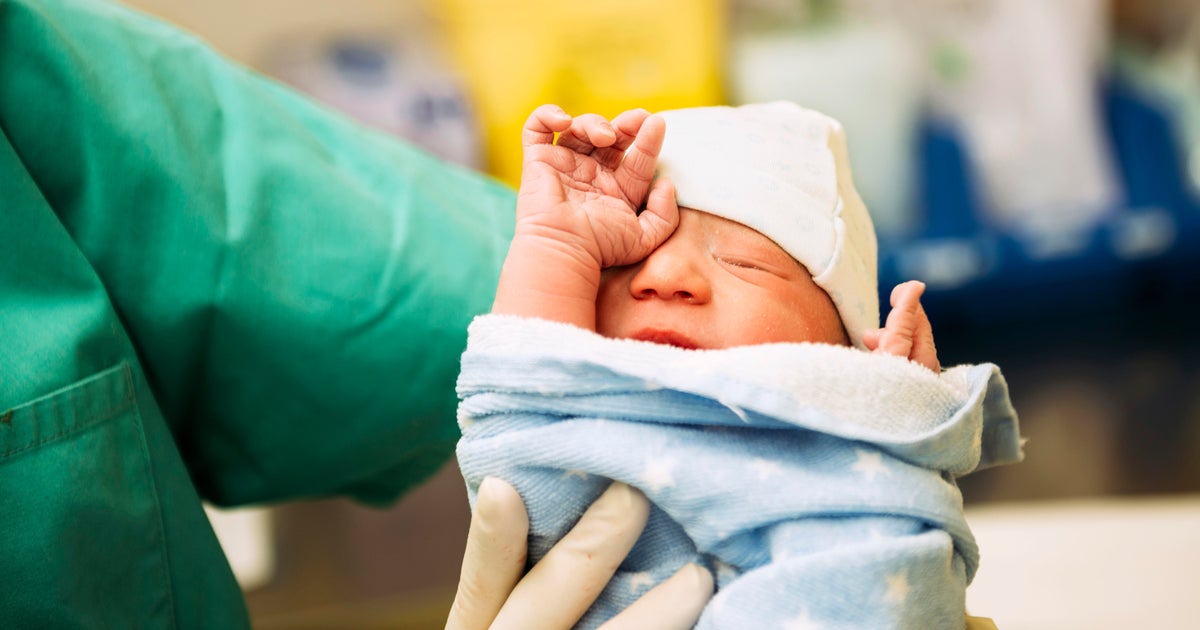
U.S. birth rate drops to record low, ending pandemic uptick
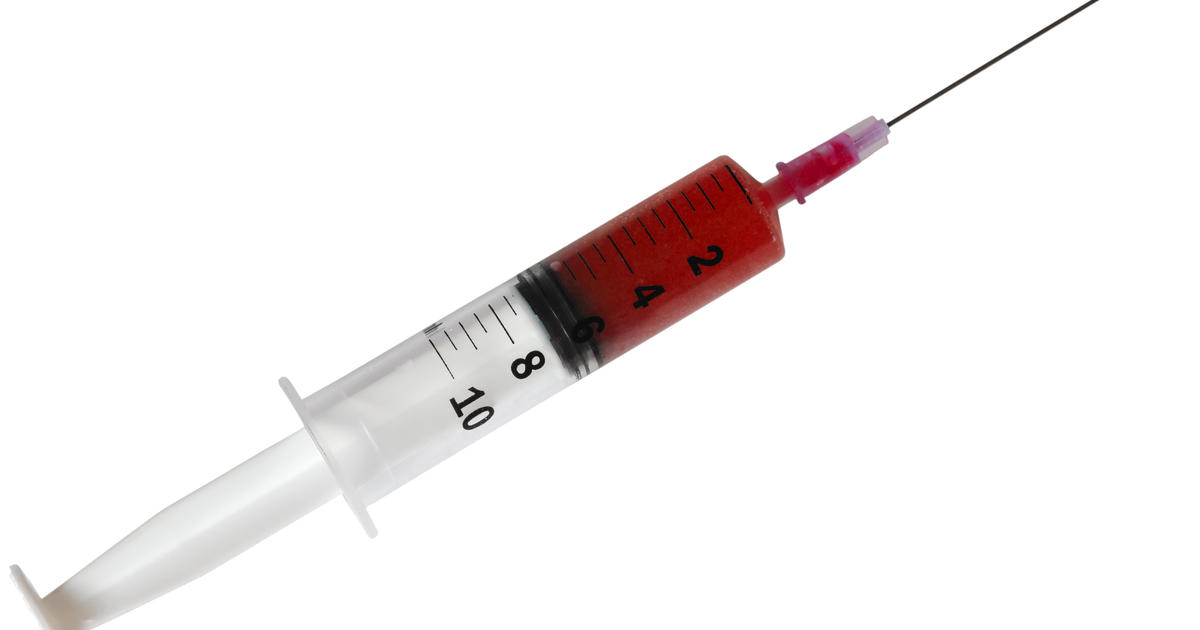
"Vampire facials" at unlicensed spa infected 3 with HIV, CDC says

Pasteurization working to kill bird flu in milk, early FDA results find

Flooding in Tanzania and Kenya kills hundreds as heavy rains continue

Nearly 200 people sick in norovirus outbreaks on Princess, Royal Caribbean ships
Nearly 200 people got sick in norovirus outbreaks on Princess Cruises and Royal Caribbean International ships.
The Centers for Disease Control and Prevention said 94 of the 2,532 guests on Sapphire Princess reported being ill during its April 5 cruise, along with 20 crew members. The round-trip cruise, which left from Los Angeles with stops in Hawaii and the South Pacific, will end on May 7, according to CruiseMapper .
On Royal Caribbean’s Radiance of the Seas, 67 of its 1,993 guests reported being ill in addition to two crew members during a cruise that ended April 22, according to the CDC . The two-week voyage sailed from Tampa, Florida to Los Angeles with stops in countries like Colombia and Panama, according to CruiseMapper .
Start the day smarter. Get all the news you need in your inbox each morning.
In both outbreaks, the guests and crew members’ main symptoms were diarrhea and vomiting.
Princess, Royal Caribbean and the ships’ crews implemented heightened cleaning and disinfection measures and isolated those who were sick, among other steps, the health agency said.
"At the first sign of an increase in the numbers of passengers reporting to the medical center with gastrointestinal illness, we immediately initiated additional enhanced sanitation procedures to interrupt the person-to-person spread of this virus," a Princess spokesperson told USA TODAY in an emailed statement. "Our sanitation program, developed in coordination with the CDC, includes disinfection measures, isolation of ill passengers and communication to passengers about steps they can take to stay well while onboard."
Royal Caribbean did not immediately respond to a request for comment.
The CDC has logged six outbreaks of gastrointestinal illness on cruise ships that met its threshold for public notification since the beginning of the year. Norovirus was listed as the causative agent in five, while one was unknown.
The illness is often associated with cruise ships but outbreaks occur in communities on land as well, according to Dr. Sarah E. Hochman, a hospital epidemiologist and the section chief of infectious diseases at NYU Langone Health’s Tisch Hospital.
“There's not something special or unique about cruise ships,” she said. “It's really any type of congregate setting, but it's also happening out in the community on a much smaller scale among households and household contacts. It just doesn't come to the attention of public health as much as it does for larger congregate settings.”
Hochman said the virus is “incredibly infectious” and congregate settings tend to have many shared surfaces, such as handrails in cruise ship stairwells or elevators. “And so, if you just have one person who's shedding the virus and touches the surface and then someone else touches it and then touches their mouth, that's how it can spread in those types of settings.”
Cruise ship medical facilities: What happens if you get sick or injured (or bitten by a monkey)
Alcohol-based hand sanitizer isn't as effective against norovirus, and Hochman emphasized that washing hands with soap and water “will do a lot to prevent the spread.”
The news comes after more than two dozen Silversea Cruises guests got sick in a gastrointestinal illness outbreak on the luxury line’s Silver Nova ship during a sailing that began in late March.
Nathan Diller is a consumer travel reporter for USA TODAY based in Nashville. You can reach him at [email protected].
This article originally appeared on USA TODAY: Nearly 200 people sick in norovirus outbreaks on Princess, Royal Caribbean ships
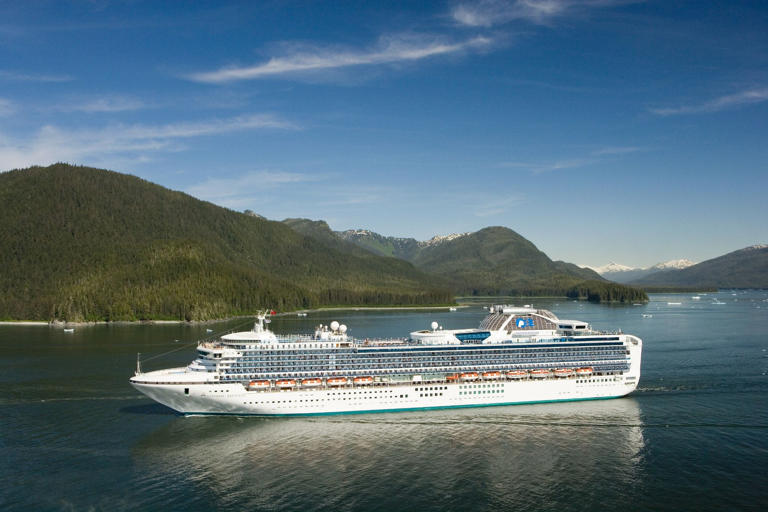
Cruise lines battle norovirus outbreaks, affecting crews, hundreds of passengers. Here's what to know
In all, about 1,700 people reported being sick with norovirus aboard a cruise ship between January and June of this year.
By Monica Galarza and Marissa Bagg • Published July 13, 2023 • Updated on July 13, 2023 at 6:49 pm
The Centers for Disease Control and Prevention is reporting the highest number of norovirus outbreaks in over a decade and it is impacting hundreds of passengers and crew members onboard some of the most prominent cruise lines.
In the first six months ending in June, cruise lines have reported 13 separate outbreaks to the CDC. It’s the most number of reported norovirus outbreaks on cruise ships since 2012.
And this year’s outbreaks represent the highest number since cruises began sailing again in the summer of 2021 after being suspended due to COVID-19.
Get South Florida local news, weather forecasts and entertainment stories to your inbox. Sign up for NBC South Florida newsletters.
One local expert says it’s in part because more people are cruising.
“The hundreds of thousands, if not millions of people that have already gone on cruises without incident. It’s a very small number and it’s there’s nothing to be concerned about,” said Steward Chiron, a cruise expert. “I would not think twice about going on a cruise. I would not think twice about going on a cruise or traveling anywhere.”
Celebrity, Royal Caribbean International, Holland America, Princess and P&O were among the Royal Caribbean and Carnival lines affected.

Several people detained after two victims were robbed at gunpoint in Wynwood: Police

These are the countries where refugees in Florida are coming from
So if you're planning to set sail this summer, here's everything you need to know about the norovirus.
What is norovirus?
According to the CDC, norovirus is the leading cause of vomiting, diarrhea, and foodborne illness in the United States.
It's also not a one-and-done virus. You can get norovirus illness many times in your life because there are many different types of noroviruses and one type may not protect you against the others.
It is possible, however, to develop protection against specific types, but it's not known exactly how long protection lasts.
This may explain why so many people of all ages get infected during norovirus outbreaks.
According to the CDC, your likelihood of getting a norovirus infection is also determined in part by your genes.
How does norovirus spread?
Because people of all ages can get sick with norovirus, it can spread easily and quickly.
The CDC says norovirus can be spread by:
- Having direct contact with someone with norovirus, such as by caring for them, sharing food or eating utensils with them, or eating food handled by them.
- Eating food or drinking liquids that are contaminated with norovirus.
- Touching surfaces or objects contaminated with norovirus and then putting your unwashed fingers in your mouth.
You are at your most contagious when you have symptoms of norovirus illness, especially vomiting or during the first few days after you feel better.
But studies have shown that you can still spread norovirus for two weeks or more after you feel better.
According to Mayo Clinic , norovirus most often spreads in closed and crowded environments, such as hospitals, nursing homes, child care centers, schools and cruise ships.
But it can also spread through contaminated food, water or through sick people and contaminated surfaces.
What are the symptoms of norovirus?
According to the CDC, the most common symptoms of norovirus are diarrhea, vomiting, nausea and stomach pain.
You may, however, experience fevers, headaches, and body aches.
Symptoms usually last one to three days and most people recover, according to the Mayo Clinic.
How do you treat norovirus?
There is no specific medicine to treat people with norovirus illness.
If you have norovirus illness, the CDC recommends you drink plenty of liquids to replace fluid lost from vomiting and diarrhea and help prevent dehydration.
Sports drinks and other drinks without caffeine or alcohol can help with mild dehydration, but these drinks may not replace important nutrients and minerals.
It is important to note that antibiotic drugs will not help treat norovirus infections because they fight bacteria, not viruses.
When was the most recent norovirus outbreak on a cruise ship?
The CDC's latest report of a norovirus outbreak happened on Viking Neptune, a cruise ship owned by Switzerland-based Viking Cruises, during a voyage from June 6 to June 20.
According to the CDC, 110 of 838 passengers and nine of the 455 crew members reported feeling ill during the trip.
The following ships saw outbreaks so far in 2023: Celebrity Summit, Nieuw Amsterdam, Grand Princess, Emerald Princess, Enchantment of the Seas, Celebrity Equinox, Celebrity Constellation, Ruby Princess, Viking Neptune, Jewel of the Seas, Brilliance of the Seas, Arcadia.
What can I do to prevent contracting norovirus?
The key to preventing norovirus , and most other illnesses is simply washing your hands well.
Norovirus is very contagious, but you can take steps to stop it from spreading.
Wash your hands often with soap and water for at least 20 seconds, especially:
- After using the toilet or changing diapers.
- Before eating, preparing, or handling food.
- Before giving yourself or someone else medicine.
It is important to continue washing your hands often even after you feel better.
Chiron says cruise lines try to keep ships clean and limit some interactions.
“What they do is they reduce the person-to-person interactions. So when you go to the buffet for example for breakfast or lunch. Instead of serving yourself a gloved crew member will do it for you,” said Chiron.
When on board, if you see someone with norovirus symptoms, you’re urged to leave the area and alert a crew member.
Norovirus can be found in your vomit or feces (poop) even before you start feeling sick. The virus can also stay in your poop for two weeks or more after you feel better and you can still spread norovirus during that time.
Hand sanitizer does not work well against norovirus. You can use hand sanitizers in addition to hand washing, but hand sanitizer is not a substitute for handwashing.
This article tagged under:
Nearly 100 Holland America cruise passengers become ill in norovirus outbreak

Nearly 100 Holland America Line passengers got sick in a norovirus outbreak.
Among 2,522 guests on the cruise line’s Koningsdam ship, 98 reported being ill, along with 12 crew members, according to the Centers for Disease Control and Prevention . Their main symptoms were diarrhea and vomiting.
Koningsdam is currently sailing a round-trip cruise visiting Hawaii and French Polynesia that departed from San Diego on Feb. 17, according to CruiseMapper . Holland America and the ship’s crew increased cleaning and disinfection and isolated sick passengers and crew following the outbreak, among other steps, the CDC said.
“At Holland America Line, the safety and well-being of our guests and crew is our top priority. During the current voyage, a number of guests on Koningsdam reported symptoms of gastrointestinal illness,” a spokesperson for the line told USA TODAY in an emailed statement. “The cases were mostly mild and quickly resolving. We initiated enhanced sanitation protocols to minimize further transmission and the incidence of cases has since declined significantly.”
The news comes after more than 125 Cunard Line passengers got sick in a gastrointestinal illness outbreak earlier this year. Norovirus cases have also risen in the U.S. in recent weeks.
The CDC logged 14 cruise ship outbreaks that met its threshold for public notification in 2023, more than any year between 2017 and 2019. Norovirus was listed as the causative agent in all but one.
The virus is frequently associated with cruises, but Ben Lopman, a professor of epidemiology at Emory University’s Rollins School of Public Health, told USA TODAY last year that cruises make up a "tiny minority of norovirus outbreaks.” The majority take place in health care settings such as nursing homes.
Nathan Diller is a consumer travel reporter for USA TODAY based in Nashville. You can reach him at [email protected].
- CruiseMapper
- Ships and Lines
Cruise Ship Norovirus Outbreaks
Here are listed latest cruise ship Norovirus outbreaks on passenger ships, with information what is and how to avoid Norovirus on cruise ships, CDC reports, and news updates.
From the following links, you can skip the intro and jump directly to illness outbreaks in 2024 , 2023 , 2022 , 2020 , 2019 , 2018 , 2017 , 2016 , 2015 , 2014 , 2013 , 2012 , also read about Zika virus , Seasickness , Hospital (shipboard infirmary) and Mercy Ships (hospital ship Africa Mercy) .
Note: The following CruiseMapper link provides information on Coronavirus/COVID outbreaks on cruise ships .
Norovirus outbreaks on cruise ships in 2024
Cruise norovirus outbreaks updates.
Norovirus on ships is spread through contaminated water, foods and surfaces (public restrooms, railings, doorknobs, handles, board games-cards-puzzles-toys, etc). Norovirus withstands chlorine, prolonged exposure outside the body, as well as temperature extremes. Like a virus, Norwalk can't be effectively treated with antibiotics, making it extremely difficult to eliminate in closed environments - like cruise vessels.
Norovirus may incubate up to 48 hours before the symptoms appear. This makes it difficult to restrict an outbreak. Noro symptoms include nausea, vomiting (kids more than adults, abdominal cramps, diarrhea, general weakness, low fever, headache, muscle aches. The illness could last up to 5 days (depending on the person's age, general health, and severity of the exposure to the virus. Recovered patients can still spread the virus for up to 2 weeks.
Quarantining the ill passengers and crew to their cabins is mandatory (at least for 48 hours) to slow the outbreak's spread. Failing to comply with the crew's orders results in fines or even discharge from the ship.
CruiseMapper's Norovirus survey is based on official data from CDC.gov (USA's "Centers for Disease Control and Prevention"). CDC's "Vessel Sanitation Program" assists the cruise tourism industry in preventing and controlling the transmission and spread of gastrointestinal illnesses (Norovirus, ETEC) on passenger ships calling on US seaports.

This program operates under the authority of the Public Health Service Act (fda.gov, "Quarantine and Inspection Regulations to Control Communicable Diseases"). CDC sanitation inspections on passenger ships are conducted twice a year. Scores of 86 are considered passing. Among the issues that CDC health inspectors usually find on board and report are:
- food debris
- dead insects
- insect droppings
- records indicating crewmembers (including cooks and galley staff) working while sick (suffering from gastrointestinal disorders or with acute gastroenteritis/AGE symptoms)
- cracked/corroded equipment
- soiled cutting boards
- food served undercooked
- lack of safety instruction signs.
CDC cruise ship Norovirus reports
Cruise ship outbreaks are reported (posted on the CDC website) when the illness incident meets the following criteria:
- The ship falls within the purview of the Vessel Sanitation Program (VSP). This means if it carries 13+ passengers and has a foreign cruise itinerary with US ports of call in it. Keep in mind, that most departures are from US-based home ports.
- The ship cruise itinerary length is between 3 and 21 days,
- The ship carries 100+ passengers.
- The percentage of infected passengers or crew (cases reported to the ship's med staff) during the cruise is 3% or more. This means small outbreaks on cruise ships will not be reported to the CDC.
CDC cruise ship inspection fees are payable by the shipowner. Fees are based on the vessel's size. VSP doesn't charge fees for consultations related to shipping facilities renovations or new ships. Inspection fees are as follows.
- Small ships (under 3000 GT/gross tons) pay USD 1500 per inspection.
- Small ships (between 3000-15000 GT) pay USD 3000 per inspection.
- Medium ships (between 15000-30000 GT) pay USD 6000 per inspection.
- Large ships (between 30000-60000 GT) pay USD 9000 per inspection.
- Extra-large ships (between 60000-120000 GT) pay USD 12000 per inspection.
- Mega-liners (above 120000 GT) pay USD 18000 per inspection.
Note: When the itinerary doesn't include US cruise ports, the ship is not required to report to CDC, thus no official illness outbreak report would be issued.
CDC ship illness outbreak investigations
VSP (abbrev "Vessel Sanitation Program") monitors CDC's observations on illness patterns for GI (gastrointestinal) outbreaks on passenger shipping vessels ( ferries and cruise ships ).
- VSP conducts outbreak investigations only in cases with 3% or more passengers or crew reported sick with GI symptoms. VSP may also conduct outbreak investigations in cases of unusual GI illness patterns (even if the rate is less than 3%).
- VSP conducts outbreak investigations only on vessels visiting ports in the USA or which are within 15 days of arriving at a US port.
- When an outbreak occurs, VSP asks for ship logs and infirmary records of reported GI cases (symptoms and timing) and illness distribution (among passengers/crew, during each day of the cruise).
- VSP staff usually boards the vessel for epidemiological assessment, interviews, distribution and analysis of illness questionnaires, monitoring cleaning procedures.
- Lab investigations - the onboard med staff often collects stool, vomit, blood specimens, which are then sent to land-based labs to confirm the illness cause.
During the onboard illness outbreak, VSP requires the cruise company to activate the "Outbreak Prevention and Response Plan" (vessel's response to illness cases).
During an outbreak:
- Cleaning and disinfection frequencies are Increased.
- Self-service buffets are stopped.
- All infected (pax/crew) are quarantined to their staterooms/cabins
- Clinical specimens are collected for analysis.
- Daily updates are provided to VSP (cases counts and measures reports)
- All passengers and crew are alerted of the illness.
- Upon boarding on the next scheduled cruise, passengers are notified about the previous voyage's outbreak.
- Occasionally, VSP requires the company to notify port authorities and also to perform cleaning and disinfection in cruise port terminal buildings.
Illness outbreaks on cruise ships (annual statistics)
The following statistics show the number of cruise ship illness outbreaks in recent years. You can compare the number of reports (CDC and news media sources) and the total number of infected (passengers and crew).
In 2014, Time Magazine published the article "The 13 Worst Norovirus Outbreaks on Cruise Ships". In it, the overall winner was Princess Cruises with 5 epidemic illness outbreaks:
- Coral Princess (February 2009, infected 271)
- Crown Princess (January 2010, infected 396)
- Crown Princess (February 2012, infected 363)
- Sun Princess (July 2012, infected 216)
- Ruby Princess (March 2013, infected 276)
Norovirus outbreaks 2023 reports
Norovirus outbreaks 2022 reports, norovirus outbreaks 2020 reports, outbreaks 2019 reports.
In the following table, you can see all 2019-reported Norovirus outbreaks on cruise ships. The listed statistical data is based on CDC or news media reports. It shows the number of sick passengers and crew (with the respective percentage to all), along with the corresponding CDC report pages (if available) as outgoing links.
Note: When the itinerary doesn't include US cruise ports, the ship is not required to report to CDC, thus no official illness report would be issued.
Outbreaks 2018 reports
In 2018, the number of reported illness outbreaks on cruise ships was 15. The total number of infected was 1177 (of those 1099 passengers and 78 crew).
Outbreaks 2017 reports
In 2017, the number of reported illness outbreaks on cruise ships was 21. The total number of infected was 2535 (of those 2450 passengers and 85 crew).
Outbreaks 2016 reports
In 2016, the number of reported illness outbreaks on cruise ships was 23. The total number of infected was 2504 (of those 2378 passengers and 126 crew).
Outbreaks 2015 reports
In 2015, the number of reported illness outbreaks on cruise ships was 23. The total number of infected was 2570 (of those 2458 passengers and 112 crew).
Outbreaks 2014 reports
In 2014, the number of reported illness outbreaks on cruise ships was 17. The total number of infected was 3559 (of those 3354 passengers and 205 crew).
Outbreaks 2013 reports
In 2013, the number of reported illness outbreaks on cruise ships was 22. The total number of infected was 2385 (of those 2249 passengers and 136 crew).
- According to CDC, in 2013 from Norovirus and similar GI (gastrointestinal) illnesses suffered a total of 1409 passengers (which is 7,5% of all passengers on the inspected cruise vessels) and 96 crew/staff members (which is 1,2% of all). With nearly 12 million cruisers departing from USA and Canada ports in 2013, the Norovirus infection rate is ~0,01% of all passengers.
- It should be noted, that in the past years on many CDC inspections was concluded the Noro virus illness source was off the ship.
Outbreaks 2012 reports
In 2012, the number of reported illness outbreaks on cruise ships was 34. The total number of infected was 5542 (of those 5079 passengers and 463 crew).
Norovirus on cruise ships
All important things you should know about the "cruise virus".
Why do Norovirus incidents happen on cruise ships? There are more than 21 million US cases reported annually, of which 1 mill related to kids. Outbreaks happen mostly during winter months and mainly in more crowded places with close quarters. Among those are schools, hospitals, nursing homes, dormitories, prisons, big resorts, bigger passenger ships (including cruise ferries ). Norovirus is often branded as "cruise ship virus" simply because on ships health officials are required to report every gastrointestinal illness incident. This means Norovirus outbreaks are reported more quickly on ships than on land. Just for comparison, the virus can afflict as many as 3000 people per day in only one big city, which is about the passenger capacity of a typical modern cruiser.
What is Norovirus infection? It's a very common, highly contagious, ruthlessly efficient and uncomfortably bad virus affecting the stomach and large intestines. Often called "stomach flu" (the med term is "Gastroenteritis") the infection results in massive vomiting and diarrhea. Sickness outbreaks are considered as such if the percentage of infected people is over 3%. The virus is not seasonal and usually not serious (in medical terms). It hits 1 in 5 people annually and is the cause of ~50% of all foodborne illness outbreaks in the USA and for ~90% of all non-bacterial gastroenteritis worldwide.
The virus is named after an outbreak in Norwalk (OH, USA). Numerous studies confirm that a quick application of hand sanitizer doesn't kill the Norovirus. It takes about 30 sec of hard rubbing with hot water and soap (including under the nails) to wash it. This virus also mutates (changing its strains). As to its efficiency - a mere 20 particles are enough to get you.
What causes Norovirus on cruise vessels is mainly contaminated food/water. When it comes to ships, it spreads mostly through physical contact with sick people or handling contaminated objects. This includes sharing food/utensils and poor hygiene (not washing hands after bathroom use). The virus also spreads fecally, so you can catch it into the onboard laundry, or while changing diapers, etc. However, many passengers likely can blame a sick crewmember for the virus. According to a survey based on 170 inspection records on ships that docked in Florida ports in 2012, on 59 cruises violations of the required illness reporting laws were reported. A total of 130 crew had gotten sick on those voyages and didn't report their illness in the required time period.
The symptoms are nausea, vomiting, diarrhea, indigestion, abdominal cramps. Also possible are mild fever and headache. It takes 1-2 days for the symptoms to appear. The illness lasts 1 to 4 days, but some people (especially elderly) may be contagious for up to 2 weeks after recovery.
What is the treatment? What to do if you got it? Obviously, the first thing is to go to the ship's infirmary (medical center) and contact the doctor. You should drink plenty of water as dehydration is a side-effect of the illness. There is no real treatment for Norovirus - you just wait it out. A few years ago an experimental Norovirus vaccine (applied as nasal spray) was developed by the "Center for Infectious Diseases and Vaccinology" (Arizona State University). The new vaccine generates a good immune response.
How to avoid Norovirus on cruise ships?
- Wash your hands often (hot water and soap), especially before/after eating and after using the bathroom
- Limit physical contacts as much as possible, pack some extra soap, a personal disinfectant (Lysol, Pepto-Bismol), oral rehydration sachets and treatments for diarrhea
- Avoid eating uncooked food (including salads and sandwiches) and food that cannot be washed (unless it can be peeled or shelled), drink only bottled liquids (preferably without ice), don't share drinks/utensils.
- Drink lots of water.
- Compensation for cruise illness. By contract, cruise lines are not required to compensate passengers who fall ill on cruises. However, they will compensate you if the itinerary was altered/canceled due to an illness outbreak. The deal may include up to 50% refund, up to 50% FCC (future cruise booking discount) or an option to cancel for a full refund plus reimbursement of airline change fees. If you have travel insurance, it covers cancellation due to illness. If you've been infected on the ship, it could also cover medical expenses and to compensate you for all days you're not on the ship before the cruise end.
The following "health advisory" list of recommended actions is often issued during gastrointestinal illness outbreak or on embarkation day (of the next scheduled voyage). It has important suggestions on how to avoid spreading the cruise ship virus infection.
- It is critical that excellent standards of personal hygiene are maintained by all on board, as well as avoiding touching surfaces, such as handrails, door handles, elevator buttons, walls.
- Report any observed evidence of vomiting or diarrhea that you may encounter on the ship.
- Ensure that you minimize direct contact with others during this time, such as handshakes, etc.
- Avoid touching your mouth.
- Wash your hands frequently and thoroughly with soap for at least 20 sec and rinse them well under running water. Ensure that you follow this procedure every time you use the WC, after coughing or sneezing, and before eating, drinking or smoking.
- Attempt to always use your own cabin toilet facilities.
- In addition to hand washing, also use the alcohol hand gels provided where available, and in particular before eating in the self-serve buffet restaurant and outdoor food outlets.
- Should you experience any symptoms of vomiting or diarrhea, return to your cabin and immediately report to the Medical Center or Front Office (Reception, if the infirmary is busy) by dialling 999.
Cruise ship virus procedures
What do they do about it? What actions do lines/operators/CDC actually take in response to a Norovirus cruise outbreak?
An "illness outbreak" is considered when 3% or more of all passengers report symptoms to the ship's med staff. In such cases, the CDC requires cruise lines to file a medical report.
The hotel staff is required to implement special cleaning and disinfection procedures for sanitizing the whole ship. To do that, they use stronger solvents, like Microbac, chlorine bleach, hydrogen peroxide. The Lido Deck's bistro/buffet service switches to manned stations. Often, salt-pepper shakers are taken off the tables. The crew starts offering precautionary tips. Sick passengers and crew are quarantined in their rooms, typically for at least 2 days. When Norovirus outbreaks can't be contained, cruise lines might also pull the ship out of service for a few days for sanitizing.
The CDC's "Vessel Sanitation Program" is for monitoring illness outbreaks on passenger ships carrying 100 or more guests on sailings from 3 to 21 days in length. The ship's medical staff is required by the CDC to maintain illness counts for each itinerary involving a stop at a US cruise port and to give CDC the number of all passengers/crew, plus the number of reported diarrhea cases during that voyage. This is done 24 hrs prior to arrival at any US port of call from a foreign port. And they file such reports even if the "illness number" is zero. This protocol only confirms that the CDC knows everything about it.
Other possible actions and results are red level ("Code Red") cleaning. The boarding/embarkation of new passengers is often delayed to permit more extensive disinfection of public areas and the cabins. Usually, a pre-embarkation health advisory is distributed to all boarding passengers. Additional med staff is sent to the ship in port to assist the disembarkation of infected passengers. Another possibility is the cruise ship to cancel all the itinerary's foreign ports of call and to return to its US home-port before the end of the voyage.
Some cruise lines offer hand-sanitizer dispensers near the ship's restaurants, Lido/pool deck areas and other more crowded public spaces in their effort to keep a lid on sickness outbreaks.
In February 2020, the shipowner cruise company Lindblad Expeditions announced the "Premium Purity" program with a shipwide cleaning system based on ACT CleanCoat technology. The program was rolled out fleetwide after a year trial. The innovative ship cleaning process is based on photocatalytic antibacterial spray that when activated by light kills viruses, bacteria, airborne microbes, mould. The disinfecting product and technology were developed by the Danish company ACT Global AS ( Copenhagen ). The spray is chemical-free, odourless, transparent and can be applied to all surfaces.
Zika virus on cruise ships
Zika virus (aka ZIKV) is a Flavivirus - from the genus of the viruses named West Nile, dengue, tick-borne encephalitis, yellow fever. These plus several other viruses may cause encephalitis (acute brain inflammation). In humans, Zika virus causes the Zika fever which is known to occur only within some equatorial regions. In 2014, Zika spread across the Pacific Ocean to French Polynesia, and soon to Easter Island. In 2015, Zika virus reached Central America, the Caribbean, and South America. In South America were recorded several pandemic outbreaks.
The most severe outbreaks were reported in Brazil, with an alarming surge in newborns with microcephaly. If the mother is infected, the virus may cause microcephaly in newborns. This is a neurodevelopmental disorder - babies are born with an underdeveloped head.
Generally, Zika is a mosquito-borne virus spread by Aedes aegypti (aka "yellow fever mosquito") and Aedes albopictus (aka "Asian tiger mosquito"). However, it became "cruise virus" since the decease can also result from intrauterine (contraceptive device), sexual intercourse, blood transfusion, lab exposure, organ/tissue transplantation, breast milk transmission.
In January 2016, the CDC issued travel guidance on affected countries and suggested using enhanced precautions and even postponing travel. Guidelines (specifically for pregnant women) were issued as well. Similar travel warnings were issued by other health agencies and governments. The CDC list of potentially dangerous for travel countries included (alphabetically) Barbados, Bolivia, Brazil, Cape Verde, Colombia, Ecuador, French Guiana, Guadeloupe, Guatemala, Guyana, Haiti, Honduras, Martinique, Mexico, Panama, Puerto Rico, Paraguay, Salvador, Samoa, St Maarten, Suriname, Venezuela.
Cruise lines should warn their pregnant passengers of the virus. Cruise ships publish daily health and safety instructions to their passengers on how to avoid mosquito bites. Zika symptoms are fever, skin rash, pain in joints, conjunctivitis (pink eye). It typically lasts from a few days to a week. For now, the illness cannot be prevented by drugs or vaccines.
"Cruise ship virus" politics
Virus outbreaks on cruise ships are actually not that uncommon. Such viral/bacterial outbreak incidents affect the vacation experience of thousands of people, being packed up in a floating resort for many days on end. In confined spaces with frequent passenger turnover (like big capacity cruise ships), it is easy for diseases to spread - whether food- or air-borne, or otherwise. However, there's a tendency to cover up the severity of this issue.
Some of the world's most famous passenger ships are listed in the virus outbreak statistics, yet one hears so little of it in mass media news. And there is no surprise in that since the "cruise illness" news are nothing but bad publicity for the companies - which is bad for a prosperous multi-billion dollar sea travel vacation business. All major cruise line companies will do their best to keep quiet about virus outbreaks on their ships. There are passenger testimonials about quarantined ships and how badly guests have been treated by the line. Virus outbreak news speaks of a lack of proper hygiene control, badly trained staff, bad ship management. The whole responsibility goes to the shipowner (cruise line company) and its management.
Major (in some cases epidemic) illness outbreaks are among the "biggies" that can bring down the brand's reputation on the market. Cruise illness issues often result in lower booking rates and cheaper prices - which is bad for the business.
So it comes as no surprise that when CDC reports an illness outbreak on some vessel, big media sources do not immediately (or ever) respond to the news. You may hear about it on your local radio station, or on your local cable operator, but not necessarily on ABC, CNN, and often not even on Yahoo and MSN news online. It's not about the passengers' health (never been) - it's about the big money that rules our world.
So keep your hands clean, keep your mind clear, always hope for the best. Bad, if meant to happen, will happen anyway, and nothing can change it.
Seasickness on cruise ships
Seasickness is physical disorientation as a result of conflicting signals received by the brain from different body senses. Our inner ear senses the ship's irregular motion, which our eyes can't see because the floor and walls are stable. Depending on individual balance, our ability to adjust to motions varies, so not everyone experiences seasickness.
Seasickness is one of the most common "cruise illnesses". Passengers sensitive to nausea or motion sickness should consult their doctors for medical recommendations prior to departure. Drugs (like Dramamine) are effective against seasickness. At the cruise ship's Infirmary, and also at Reception Desk is provided (free of charge) Meclizine. Know that the bigger the vessel the more stable it is. Also, motion in midship-located areas (including staterooms) is highly reduced in comparison to forward and aft areas.
Seasickness manifests in different ways and is always a result of the body's attempt to correct for the conflicting inputs received from its senses. Common symptoms are cold sweat, dizziness, drowsiness, headache, nausea. When such symptoms are noticed, passengers should take precautions to prevent intensifying the disorientation. The harder the symptoms, the longer the recovery.
If seasickness symptoms are accompanied by diarrhea or fever, passengers should immediately seek medical treatment for Norovirus and avoid spreading the illness to others.
How to prevent seasickness on cruise ships (tips)
Passengers prone to motion sickness are more likely to suffer seasickness. The following prevention tips can minimize discomfort, so before the cruise:
- choose more sheltered routes (clam waters). Open sea and ocean waters are rough and have larger swells, thus river cruises are among your best choices.
- Choose a large liner as larger vessels are more stable and motions are minimized.
- Book centralized/midship stateroom and/or middle deck cabin, where motions are less noticeable.
- Get a good sleep before the voyage - an energetic, well-rested body adjusts easier to new conditions.
During the cruise tips to divert seasickness symptoms include:
- Get involved in onboard activities - this will occupy your mind while the inner ear adjusts to equilibrium changes.
- Avoid napping or lying down - when the body is horizontal, the ship's motion is more pronounced.
- Avoid eating unknown foods - you don't know how your stomach may react to new food/ingredients. Avoid alcohol and acidic-fatty-spicy foods. Stay well-hydrated by drinking plenty of water.
- Walk around to adjust the body's equilibrium to the ship's motion. When on open decks, focus on the horizon to give your eyes and body similar inputs about any tilting or other motion. Depending on the symptoms' severity, it may take several hours.
- Often get fresh air, take deep breaths, keep your lungs clear.
- Some herbal remedies (in tablets or teas) also can ease the symptoms, including ginger and peppermint. Their efficacy varies by person, and are best used together with other prevention methods.
Search for medical assistance - consult the ship's physician if no actions provide relief.
Cruise ship hospital (medical care)
Cruise vessels are not "hospital ships".
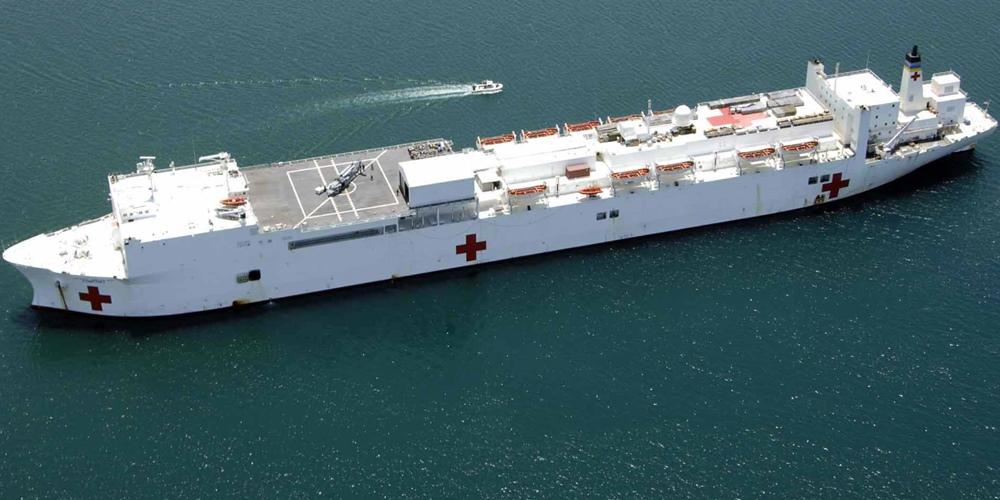
Hospital ships are designated as floating medical facilities (hospitals).
Most hospital ships are navy vessels (operated by military forces) which are specifically built for use in war zones.
Attacking a hospital ship is considered a war crime, but enemy forces have the right to board them for inspections.
As of 2018, hospital ships have Brazil (6), China (5), Russia (6), USA (2), Spain (2), and India-Indonesia-Peru-Vietnam (x1).
The navies of USA, UK, Australia, China, France, Italy, Spain, Argentina, and Japan have some classes of military ships fitted with onboard hospitals.
For passengers with health concerns, medical care on cruise ships is a vital part of their travel planning. Most cruise vessels are equipped with either basic infirmary (a small clinic) or larger hospital where sick or injured passengers are treated and cared for by contractor physicians and nurses on 24-hour duty.
Shipboard hospitals as facilities and equipment vary by cruise line and vessel. Clinic's size usually depends on the ship's capacity (passengers plus crew). Generally, bigger and newer ships offer larger and better-equipped medical facilities and are served by bigger infirmary staff.
The ship's medical personnel are independent contractors. This is for limiting the cruise company's liability. There are no internationally specified regulations governing ship infirmaries and medical staffing. Each company has its own standards provided for its passengers' healthcare.
For finding the Infirmary you can use the ship deck plans . On most vessels, the medical facilities are located midship on a lower deck (for easier access and better stability) and usually among other crew facilities. Every passenger stateroom has the Infirmary's number - posted or by the cabin's phone.
Basic medical care on cruise ships
A cruise ship's medical facility can treat only passengers experiencing minor health issues - seasickness, scrapes, sunburns, etc. More severe medical emergencies can't be handled on the ship and usually require medevacs. Coast guard helicopter teams fly to the ship, hoist the passenger (accompanied by a spouse/relative and a crew nurse) and fly them to the nearest land hospital.
Infirmary's equipment and med supplies provide only emergency response and basic treatments in order to stabilize the passenger until transferred ashore.
In cases of severe emergencies, passengers with life-threatening illnesses or injuries are evacuated off the ship - either by boat (if in or near seaport) or by rescue helicopter dispatched from nearest coast guard or other station. In some cases, nearby ships with better medical facilities may assist.
Both emergency and basic care are available on the ship 24 hours a day. All treatments are paid. Outside regular opening hours fees are higher.
Like inland hospitals, medical treatments at sea are pricey. However, unlike on land, most basic travel insurance policies don't cover medical treatments on cruise ships as they are not from the patient's primary caregiver. Purchasing cruise travel insurance with health coverage (medical clauses) is highly recommended.
Shipboard medical service fees vary and are usually set by medical practitioners. General consultations incur costs similar to home visits. Prescription medications or other treatments cost extra. In most cruise ship hospitals, some supplies and medications are provided to passengers and crew for free - like aspirin, seasickness pills, small bandages.
Mercy Ships
"Mercy Ships" is a charity accredited by Better Business Bureau. It operates hospital ships since 1978 and also has currently the world's largest hospital ship (excluding navy vessels) - MV Africa Mercy.
The organization provides free humanitarian aid worldwide, including health care, community development, and health education projects, mental health, agriculture, and water development programs in mainly developing countries in Africa, Caribbean, South America, Oceania.
The organization's headquarters are in Garden Valley (Texas USA), with another 16 offices worldwide - in UK, Spain, Canada, Germany, France, Denmark, Switzerland, Belgium, Holland, Sweden, Norway, South Africa, Australia, New Zealand, South Korea.
Financial support and supplies are mainly through donations from medical companies (medications, supplies, equipment), corporations (fuel, food, building supplies), governments (port fees, drydock costs), general public and also by the crew (all volunteers on a rotational basis). The crew serves with short-term (2 weeks to 2 years) and long-term (min 2 years) contracts. Volunteer crew members occupy both medical (surgeons, dentists, nurses) and general jobs (deckhands, seamen, engineers, machinists, electricians, teachers, cooks, welders, plumbers, agriculturalists.
The crew on Mercy Ships pay all costs associated with their service - fees, travel expenses, passports, insurance, personal expenses.
As 95 of the world's top 100 largest megapolises are port cities, "hospital ships" could provide healthcare very quickly and more efficiently to large numbers of people.
MV Africa Mercy
MV Africa Mercy is a converted former rail ferry (1980-built as "Dronning Ingrid") drydock-refitted in 2007 at Cammell Laird shipyard (Hebburn, England).
The ship project started in March 1999 with the vessel's acquisition through a donation from Balcraig Foundation (UK), which purchased the boat for US$6,5 million.
Ferry's train deck was reconstructed and converted into a hospital. Project's total cost was over USD 62 million.
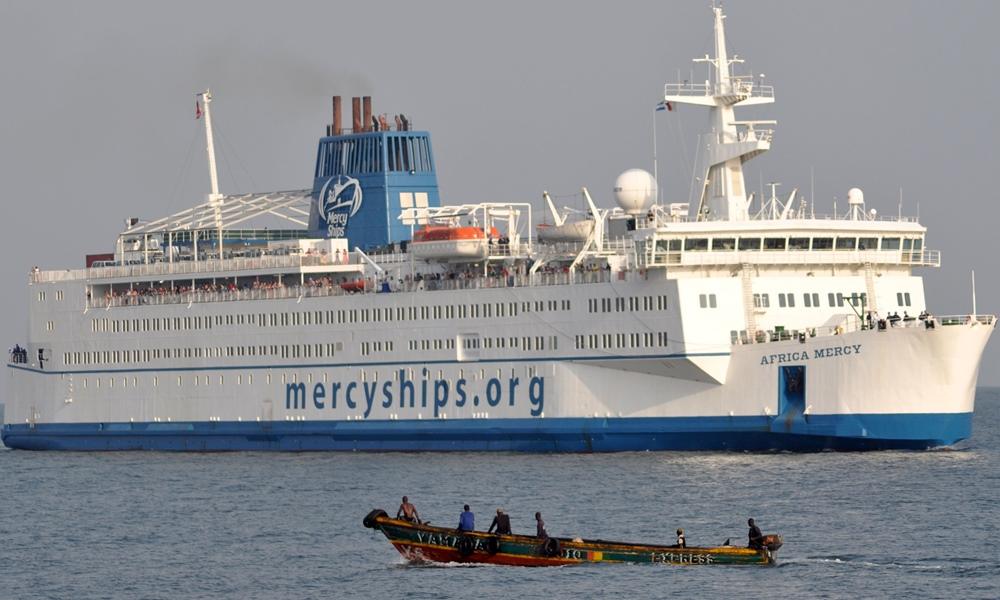
Vessel details include:
- Volume/GT tonnage 16572 tons
- LOA length 152 m (499 ft )
- Width 23,7 m (78 ft)
- Draft 6 m (20 ft)
- Powerplant 4x BW main engines plus diesel generators
- Propulsion two shafts with controllable pitch propellers
- Speed 19 Kn/35 kph/22 mph
- Passenger capacity 484
- Crew capacity 450
- Fleet of 28 vehicles (used in land-based operations)
- Annual drydock maintenance and refurbishment are done in Durban (South Africa).
As for facilities and amenities, the hospital ship has 5 operating rooms, Intensive Care Unit, an ophthalmic unit, CT scanner, X-Ray, labs, recovery ward (82 beds), a daycare center, a school (for all ages), library, launderette, convenience store, restaurant, gymnasium, shops, Starbucks Cafe (donated), satellite communications.
Africa Mercy has a total of 126 staterooms for the staff/crew. They are located on upper decks and include cabins for families, couples and single cabins.
Land-based operations ("Field Service") include mobile clinics providing screening for potential surgery patients, healthcare, dental care, also mental health programs, infrastructure projects.
How common is norovirus on cruise ships? Here’s why you shouldn’t worry

What's sneaky, super contagious and bound to cause diarrhea and vomiting? If you answered "norovirus," you'd be correct. But what is it, and why is it often associated with cruises?
An excessive number of news reports exist for norovirus cases on ships, making it seem to the unsuspecting public that cruise vessels are dirty or you're likely to get sick if you sail . I'm here to set the record straight.
Find out why norovirus is unfairly labeled a cruise ship illness, what cruise lines do to minimize onboard spread and whether you should be worried about it on your next voyage.
For more cruise news, guides and tips, sign up for TPG's cruise newsletter .
What is cruise ship norovirus?

Norovirus is the most common of several viruses that cause severe gastrointestinal illness or acute gastroenteritis. Symptoms may include diarrhea and vomiting, as well as abdominal cramping, headaches, muscle aches and fever — an unpleasant experience any time but especially when you're on vacation.
Norovirus is highly contagious and spreads when you touch a contaminated surface and then put your fingers in or near your mouth, such as when eating without washing your hands. It's also frequently spread through contaminated food, sometimes earning it the nickname "food poisoning," even though there are many pathogens that can cause foodborne illnesses. You might also hear it generically called a stomach bug or the stomach flu despite the fact that noroviruses are not the same as flu viruses.

How does norovirus spread on cruise ships?
What causes norovirus on cruise ships, anyway? Norovirus spreads easily in close quarters, such as those found on cruise ships. Although it can spread from person-to-person contact, on vessels, it's most commonly passed when passengers fail to wash their hands after coming in contact with high-touch areas, such as handrails, elevator buttons and serving utensils in the onboard buffets.
Infected passengers who don't wash their hands after coughing, sneezing or using the restroom are the reason those surfaces become contaminated in the first place. To avoid both spreading your own germs and picking up the germs of others, wash your hands frequently, especially before eating, for at least 20 seconds with soap and warm water, making sure to scrub around your fingernails and between your fingers.
Contaminated food is also a cause, but it's not as common on ships, where the staff is meticulously trained to follow health and safety guidelines for sanitation. Standards are enforced by the U.S. Centers for Disease Control and Prevention. (See the next section for more.)
What do cruise ships do to prevent norovirus outbreaks on board?

Cruise lines employ crews dedicated to keeping public areas and high-touch surfaces clean. Galley crews and waiters receive extensive training on food safety and handling.
Lines also screen passengers for signs of illness at embarkation. They ask passengers who feel ill during their cruises to report symptoms to the medical center and keep themselves isolated in their cabins.
On ships where outbreaks occur, the crew conducts a deep cleaning of the ship after passengers have disembarked and before the next sailing begins. In cases where outbreaks are particularly severe, subsequent sailings could be canceled to allow for more thorough sanitization.
Additionally, the CDC's Vessel Sanitation Program, implemented in the 1970s, subjects all passenger ships carrying 13 or more people to random, unannounced inspections if they wish to call on ports in the United States.
As part of the program, ships are required to adhere to stringent health and safety protocols that dictate everything from the cleaning of high-touch areas to how food is stored in freezers, refrigerators and galleys.
VSP inspectors board ships and conduct thorough checks to ensure compliance, and the standards are high. A score of less than 86 out of 100 is considered failing. You can find a list of the most recent inspection scores and lists of violations for each ship on the VSP website .
Should you worry about getting norovirus on a cruise?
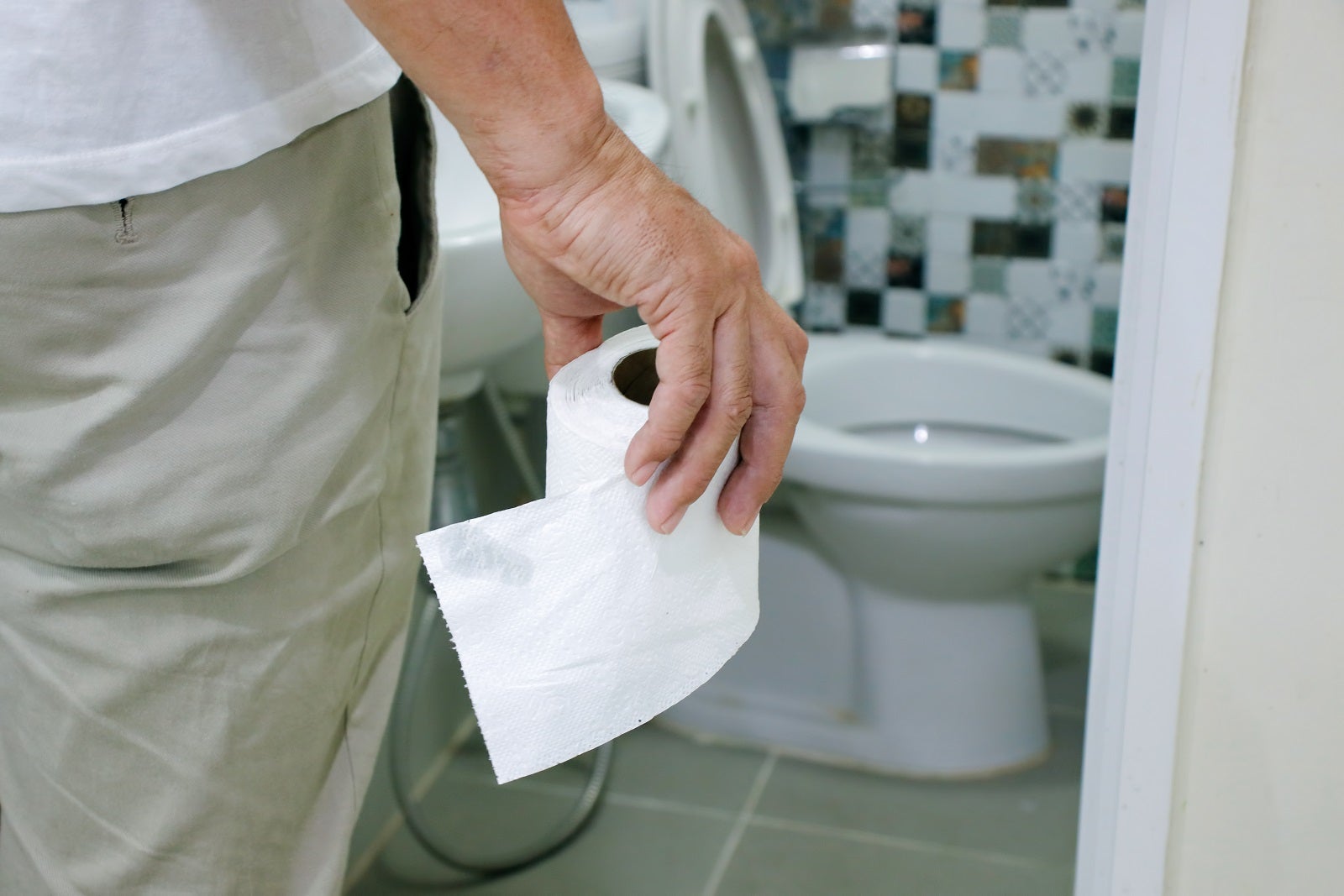
The short answer is no. "People often associate cruise ships with acute gastrointestinal illnesses, such as norovirus, but acute gastrointestinal illness is relatively infrequent on cruise ships," the CDC says on its " Facts About Noroviruses on Cruise Ships " page.
Based on the math, you have less chance of catching a gastrointestinal illness on a ship than at many places you're likely to visit on land.
The CDC estimates only about 1% of all annual U.S. norovirus cases happen on cruise ships. The numbers are greatest in nursing homes, hospitals, schools and restaurants, which collectively account for about 91% of cases.
In a study of acute gastroenteritis cases from 2006 to 2019 (before the cruise industry's COVID-19 shutdown), the CDC found that the number of cases on ships decreased over those 14 years. It also noted that the number of cases tends to be higher on larger ships and on voyages of a week or longer.
"The rate of … illness on cruise ships decreased during 2006-2019 for passengers and crew," the report says. That's good news for cruisers.
During that time frame, approximately 127 million passengers sailed on the 252 cruise ships under VSP jurisdiction. Of those 127 million cruisers, 26,450 reported symptoms of gastrointestinal illness while on board. It sounds like a large number, but it amounts to just 0.02% (two one-hundredths of one percent) of cruisers throughout those 14 years, with the total number of cases decreasing from 4,507 in 2006 to 1,201 in 2019.
If you'd like to check out the outbreak information, you can find a detailed list of ships that have had acute gastroenteritis outbreaks (many of which were caused by norovirus), listed by year, about halfway down the CDC's outbreak page .
For more details on how to keep yourself healthy on board, visit TPG's story on how to avoid getting sick on a cruise .
Why are there so many cruise norovirus reports on the news?

The simple answer is that cruise ships are required to report cases of acute gastroenteritis to the CDC, even when the numbers are low. In contrast, other entities — schools, nursing homes, hospitals and restaurants — are not.
"Health officials track illness on cruise ships. So outbreaks are found and reported more quickly on a cruise ship than on land," reads the CDC's facts page .
Specifically, the medical staff from each cruise ship must submit a report with the number of ill passengers within 24 to 36 hours of its arrival at a U.S. port from a foreign port, even when no cases of gastrointestinal illness are present. They must also submit reports if 2% or more of the passengers and crew become ill and the ship is scheduled to visit a U.S. port within 15 days. If the number hits 3% or more, cases must be reported to the CDC even if the ship is not scheduled to call on a U.S. port within the next 15 days.
That means data for norovirus on cruise ships is more readily available than for other entities. It's easy to make norovirus case numbers sound alarming, but context matters. For example, 100 cases on a single ship might seem like a lot, but on a vessel like Oasis of the Seas, which carries more than 5,400 passengers, 100 cases are only about 2% of the onboard population.
Bottom line
Should you be worried about catching norovirus or another gastrointestinal illness when you cruise? The CDC says cruises account for some of the lowest case numbers in the U.S. annually.
Your chances of finding yourself confined to your room and hunched over a toilet for a week are slim when you sail, especially if you take common-sense precautions like washing your hands and not sharing drinks, utensils and other items that easily spread germs.
Have more cruise questions? TPG has answers:
- Are cruises safe? Here's what you need to know before you sail
- Packing for a cruise? These items aren't allowed on board
- Man overboard: Cruise ship overboards and how they happen
- What is baked Alaska, and why is it paraded around cruise ships?
- What are the largest cruise ships in the world?
- Gentlemen hosts: These men cruise to make sure single ladies have a great time
- What is the Jones Act and how does it affect cruise ships?
- What is a lido deck on a cruise ship?
- What's a cruise cabin guarantee and will it save you money?
- What's the difference between a cruise ship concierge and a butler?

- April 24, 2024 | Shedding Pounds, Dodging Cancer: The Life-Saving Promise of Bariatric Surgery
- April 24, 2024 | Quantum Computing Meets Genomics: The Dawn of Hyper-Fast DNA Analysis
- April 24, 2024 | Scientists Turn to Venus in the Search for Alien Life
- April 24, 2024 | NASA Astronauts Enter Quarantine As Boeing Starliner Test Flight Approaches
- April 23, 2024 | Peeking Inside Protons: Supercomputers Reveal Quark Secrets
Surge at Sea: Alarming Increase of Norovirus Outbreaks on Cruise Ships
By SciTechDaily July 14, 2023
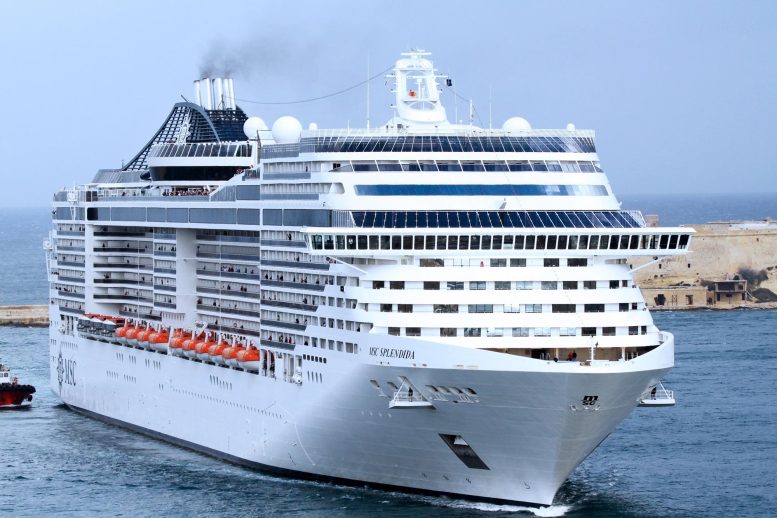
The allure of the open sea, captivating itineraries, and the luxurious promise of a carefree escape have long made cruising a popular choice for vacationers. However, this industry’s lustrous appeal has recently been overshadowed by a surge in outbreaks of a particularly stubborn and contagious pathogen — Norovirus.
Since the start of this year, an unsettling trend has emerged. According to data compiled by the Centers for Disease Control and Prevention (CDC), there have been 13 outbreaks across six different cruise lines. This alarming number marks the highest incidence of such outbreaks since 2012 when there were 16 across eight lines over the entire year.
In light of these recent developments, it’s imperative to explore and understand the nature of Norovirus — what it is, why it’s a recurring issue aboard cruise ships, and its impact on the cruise industry. This article aims to shed light on these matters, unpacking the complexities of the problem, and highlighting the steps that are being taken to address it.
The recent surge in Norovirus outbreaks underscores the necessity of vigilance and proper understanding of this issue, both for those planning a dream vacation at sea and for those in the cruise industry itself. Together, we can work towards ensuring that cruise ships remain a place of relaxation and enjoyment, rather than a breeding ground for this troublesome virus .
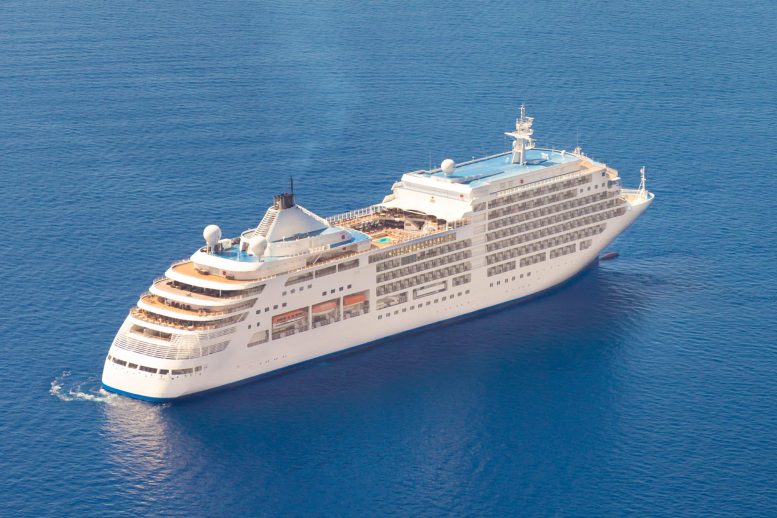
What is Norovirus?
Norovirus, sometimes referred to as the “winter vomiting bug,” is a highly contagious virus that causes gastroenteritis, an inflammation of the stomach and intestines. Named after Norwalk, Ohio, where the first outbreak was identified in 1968, norovirus can lead to severe vomiting, diarrhea, stomach cramps, and, in certain cases, even more serious consequences such as severe dehydration.
The virus is commonly spread through direct contact with an infected person, consuming contaminated food or water, or touching surfaces or objects contaminated with the virus. One of the main challenges in containing norovirus is its ability to survive on various surfaces for a significant amount of time, making it easy to pick up unknowingly.
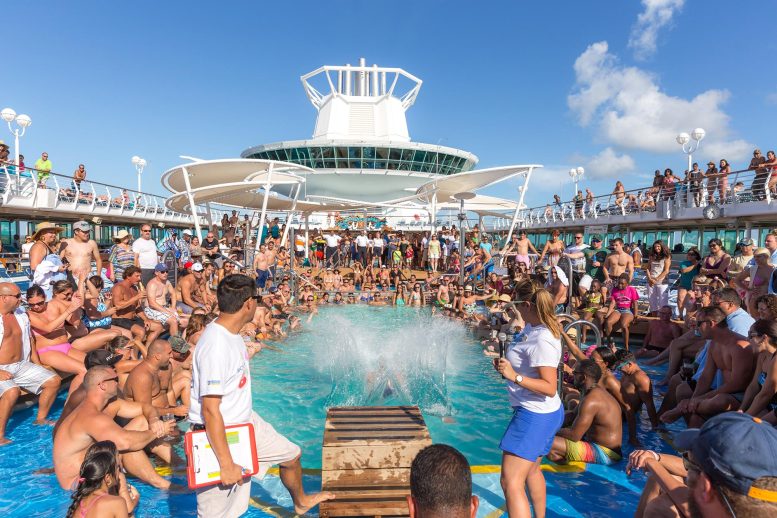
Why is Norovirus a problem on Cruise Ships?
Highly contagious in close quarters.
The design and operation of cruise ships often involve large groups of people living in close proximity, sharing dining areas, entertainment spaces, and public restrooms. This makes it easy for norovirus to spread rapidly from person to person.
Quick and Vast Outbreaks
When a single case of norovirus appears on a cruise ship, it can quickly become an outbreak affecting hundreds or even thousands of people. This can happen incredibly quickly due to the confined nature of a cruise ship and the frequency of close interactions among passengers and crew.
Contaminated Food and Water
Cruise ships are known for their vast buffets and dining options. This presents an opportunity for the virus to spread if food or water becomes contaminated, either by an infected person or through improper handling and storage.
Difficulty in Proper Sanitation
While cruise ships have strict sanitation practices, the resilience of norovirus complicates matters. The virus can survive for days on surfaces and is resistant to many common disinfectants, making it challenging to eliminate once an outbreak has occurred.
Interruption of Planned Activities
A norovirus outbreak can cause significant disruption to the planned activities and itineraries of a cruise. Infected individuals must be isolated, common areas may need to be closed for cleaning, and in severe cases, the ship may even have to return to port.
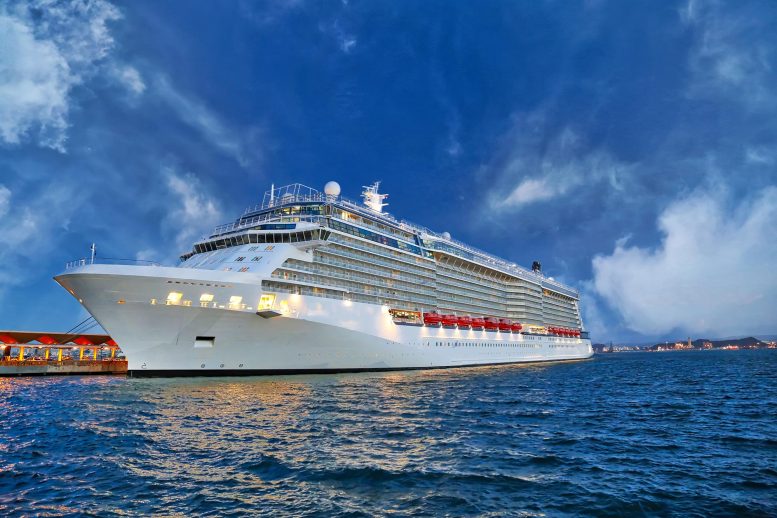
The Impact of Norovirus on Cruise Industry
Cruise lines have had to invest heavily in cleaning and sanitation protocols, disease detection methods, and passenger education to combat the threat of norovirus. In many instances, outbreaks have led to public relations challenges, decreased passenger satisfaction, and financial losses due to trip cancellations and medical costs.
Moreover, the cruise industry often finds itself under scrutiny following an outbreak, which can affect the public’s perception and willingness to book cruises, ultimately impacting the industry’s bottom line.
The threat of norovirus on cruise ships is a serious issue that has both health and economic impacts. The confined environment of a cruise ship, combined with the virus’s highly contagious nature, creates a significant challenge. It’s crucial for cruise lines, passengers, and health officials to remain vigilant, proactive, and informed to prevent and contain potential norovirus outbreaks.
While the industry has made strides in improving sanitation protocols and disease prevention measures, the threat of norovirus remains a considerable concern that must be continuously addressed to ensure the safety and well-being of all passengers at sea.
More on SciTechDaily

Smartphone Norovirus (‘Cruise Ship’ Microbe) Detector [Video]

Using a Smartphone to Detect Norovirus (Winter Vomiting Bug)

The Looming Marburg Crisis: How Virus Outbreaks Escalate and Spread

Study Reveals Copper Alloys Destroy Highly Infectious Norovirus

Monkeypox Outbreak: “This Is an Entirely New Spread of the Disease”

COVID, Bird Flu, Monkeypox – A Virologist Explains the Surge of Virus Outbreaks Around the World

Invasive Species “Hitchhiking” on Ships Threaten Antarctica’s Unique Ecosystems

Norovirus Clusters Known to Cause Stomach Flu Are Resistant to Environmental Stresses and UV Disinfection
2 comments on "surge at sea: alarming increase of norovirus outbreaks on cruise ships".
Pay tons of money to be crammed onto a petri dish and no way off, no thanks. Then once you are on board its more $$$ for anything.
I might enjoy a cruise in a small ship with a few people, but having done a trip on a large ship many years ago I found all the hobnobbing with hundreds of other people to be psychologically scream-making ! Far too many humans in one place – no amount of luxury things would compensate for the horror of that, let alone worrying about a virus. So no thanks !
Leave a comment Cancel reply
Email address is optional. If provided, your email will not be published or shared.
Save my name, email, and website in this browser for the next time I comment.
We asked: Should I cancel a cruise if my ship had norovirus?
Does it matter what happens on the cruise before your cruise we asked infectious-disease experts for answers..

Traveling has always come with complications. Our By The Way Concierge column will take your travel dilemmas to the experts to help you navigate the new normal. Want to see your question answered? Submit it here .
“What do you do if you’re a passenger on a cruise directly following a norovirus outbreak? Should you rebook?” — Washington Post travel reporter Andrea Sachs
Even though it feels as if we hear a lot about gastrointestinal illness on cruise ships, the Centers for Disease Control and Prevention says outbreaks are “relatively infrequent.” Because health officials track illness on cruises, outbreaks are found and reported quicker on ships than on land, the CDC says.
But it happens . So far this year, the CDC has reported 13 outbreaks of norovirus — more than the annual total of gastrointestinal illnesses reported on cruise ships visiting U.S. ports in each year dating back to 2017; the CDC imposed a no-sail order for much of 2020 because of the coronavirus pandemic, and U.S. cruises were required to follow pandemic-era restrictions until January 2022 , which may have also helped contain norovirus . Although outbreaks may affect more than 100 passengers, the two most recent cases represented about 13 percent and 7 percent of guests, respectively.
So how far do you need to go to evade the stomach bug on your vacation?
Let’s start with what I heard from Bernadette Boden-Albala, the director and founding dean of the Program in Public Health at the University of California at Irvine, who has extensively researched and studied norovirus and is still a fan of cruise travel. In fact, she emailed me from a cruise ship.
Her take: You don’t need to rebook if you hear there has been an outbreak on the sailing before yours. You and the cruise line are on the same page: Nobody wants you getting sick on board.
“Norovirus is a worst fear for all cruise lines,” Boden-Albala says.
She mentioned information you’ll also find on the norovirus page of the Cruise Lines International Association website: When a gastrointestinal illness plagues a cruise, the captain and crew follow deep-cleaning and sanitation practices developed with public health authorities. Additionally, Kendra Holmes, the CEO of Miray Cruises, says a ship’s crew is monitored for symptoms, and if anyone does display symptoms, they’re quarantined and treated.
Shoshana Ungerleider, a board-certified internal medicine physician and host of the “TED Health” podcast, also says that, thanks to the norovirus cleaning protocols on ships, the risk of getting an infection on the following cruise should be quite low.
Flying during summer storm season? Better have a backup plan.
“That being said, norovirus is highly contagious and can be spread from person to person,” she wrote in an email. “If any of the crew members were infected and are still in the incubation period or showing symptoms, there might be some risk of transmission.”
According to the CDC, the incubation period for norovirus — the time it takes between infection and the onset of symptoms — is between 12 and 48 hours.
So the decision to travel or not should depend on several factors, Ungerleider says, including your personal health status and risk tolerance.
For most young and healthy people, norovirus isn’t much of a health risk, says Eyal Leshem, an infectious-disease expert at Sheba Medical Center who previously worked at the CDC. With some hydration and rest, you should recover within days.
But for elderly people or those who suffer from chronic illnesses, Leshem says norovirus can cause severe disease, which may occasionally result in hospitalization and even death. He would advise such travelers to follow up to make sure the ship has followed the CDC’s guidance and recommendations for outbreaks.
Have a travel dilemma for By The Way Concierge? Send it to us here.
Ungerleider says those high-risk travelers may want to consider rebooking their trip for the peace of mind alone.
But not all cruise ships are the same, Boden-Albala says; you can allay some of your fears by choosing ships that come with less risk. Because norovirus risks increase when you have lots of people inside close quarters, look for smaller ships that carry fewer passengers and give you lots of opportunities to spend time outdoors. (So, not a ship like this .)
On board, Boden-Albala avoids crowded situations. “I rarely use a buffet,” she says.
Most importantly, wash your hands a lot. Boden-Albala says this is the best measure you can take to protect yourself and your loved ones from the potential spread of disease. Do it the way you relearned during the pandemic: with soap and warm water for at least 20 seconds, scrubbing around and under your fingernails and between your fingers. Do it not just before eating or drinking, but also before brushing your teeth, blowing your nose, changing a diaper, et cetera.
“You must be diligent beyond your common understanding of when to wash your hands, because there are millions of norovirus particles spreading in various areas,” Boden-Albala says.
You can use hand sanitizer in addition to — but not as a substitute for — hand-washing, as Boden-Albala notes that it doesn’t do well against norovirus on its own.
Lastly, “if you see someone sick like vomiting or having diarrhea, remove yourself from the area and notify cruise staff if they are not already aware,” Boden-Albala says.
Hannah Sampson contributed to this report.
More travel tips
Vacation planning: Start with a strategy to maximize days off by taking PTO around holidays. Experts recommend taking multiple short trips for peak happiness . Want to take an ambitious trip? Here are 12 destinations to try this year — without crowds.
Cheap flights: Follow our best advice for scoring low airfare , including setting flight price alerts and subscribing to deal newsletters. If you’re set on an expensive getaway, here’s a plan to save up without straining your credit limit.
Airport chaos: We’ve got advice for every scenario , from canceled flights to lost luggage . Stuck at the rental car counter? These tips can speed up the process. And following these 52 rules of flying should make the experience better for everyone.
Expert advice: Our By The Way Concierge solves readers’ dilemmas , including whether it’s okay to ditch a partner at security, or what happens if you get caught flying with weed . Submit your question here . Or you could look to the gurus: Lonely Planet and Rick Steves .

- Search the site GO Please fill out this field.
- Newsletters
Norovirus Outbreaks on Cruise Ships: How to Avoid Getting Sick on Vacation
:max_bytes(150000):strip_icc():format(webp)/7cZXd_5cLI7mNtZRS31XzPzGTeA8lh_k24WTXKJk-mo-3956d73663764f15bce8e3e4ea4d59fa.jpeg)
- There have been 13 norovirus outbreaks on cruise ships in 2023.
- Experts note that the highly congested environment, as well as the fact that people have not been exposed to as many illnesses due to the COVID-19 pandemic, are likely the reason for the increased norovirus numbers.
- Experts recommend maintaining proper hygiene habits and contacting the ship’s medical facility as soon as you don’t feel well in order to avoid spreading illnesses while at sea.
Multiple cruise lines are experiencing norovirus outbreaks.
There have currently been 13 norovirus outbreaks on cruise ships in 2023. The most recent outbreak occurred on a Viking Cruises ship, which traveled from Iceland and docked in New York City. About 13% of its passengers and several crew members became ill with the virus while on board.
With more than 31 million passengers worldwide expected to set sail this year, experts told Health that these highly-congested environments—along with the fact that people have not been exposed to a normal amount of illnesses due to the pandemic—could be the reasons for the increased numbers.
“Loosening of restrictions after the COVID-19 pandemic makes us more susceptible to picking up viruses after several years in seclusion,” Sanjiv Shah, MD, MPH , an infectious disease specialist and chief medical officer for MetroPlusHealth, New York City’s public health insurance program, told Health.
“Children who have been able to avoid the virus during the pandemic are now being exposed to viruses that tend to peak during the school year,” he said. “While norovirus is higher this year, the numbers are not a big outlier compared to pre-pandemic levels.”
Getty Images / Michael Dunning
What Is Norovirus?
Norovirus is the most common cause of gastroenteritis and foodborne illness . Though people often call it the “ stomach flu ,” it has nothing to do with flu, Brian Labus, PhD, MPH, REHS , an expert in infectious diseases, told Health .
“You have to swallow the virus to get sick,” Labus, an assistant professor in the Department of Epidemiology and Biostatistics at the UNLV School of Public Health, said. “That can be through consuming contaminated food or touching a contaminated surface and then touching your mouth or not washing your hands before you eat.”
Norovirus, which causes inflammation of the stomach or intestines, typically causes diarrhea , vomiting, nausea, and stomach pain Bernadette Boden-Albala, DrPH, MPH , director and founding dean of the Program in Public Health at the University of California Irvine told Health . Other symptoms can include fever, headache, and body aches.
Typically, norovirus lasts for one to three days, though you can spread the illness for a few days after.
“Infected people spread the virus widely and make it difficult for public health officials to contain the virus,” Boden-Albala said.
Why the Number of Norovirus Outbreaks Increased
The exact cause for the increase in the number of norovirus cases is not clear, but the increasing demand for cruises could be one explanation for the rise in reported cases, said Labus.
During COVID, the options for cruises were limited, but now that restrictions have been lifted , more people are deciding to take that cruise they had been putting off.
People also are more likely to get sick now since pandemic restrictions have been lifted. For the past few years, people have not been exposed to as many common viruses and illnesses and now that exposure is rising, illnesses are bound to rise as well.
It also is possible the numbers for norovirus on cruise ships appear more alarming than they truly are.
On cruise ships, health officials are legally required to track any illnesses that occur, while this same reporting is not required on land. For this reason, the Centers for Disease Control and Prevention note that outbreaks are reported more frequently on sea than on land.
“The risk of getting norovirus each year is about 1 in 15 [but] a cruise passenger has about a 1 in 5,500 risk of getting norovirus,” Sally Andrews, vice president of strategic communications and public affairs for the Cruise Lines International Association told Health .
Environments Where Norovirus Spreads Quickly
According to Shah, norovirus spreads rapidly anywhere there are large groups of people, like school classrooms, family gatherings, and weddings.
Cruise ships in particular have many of the conditions that make people susceptible to norovirus—close quarters, enclosed spaces, communal dining, and high turnover of passengers.
“The virus is often associated with cruise travel simply because health officials are required to track illnesses on ships,” Shah said. “The CDC estimates only about 1% of annual U.S. norovirus cases happen on cruise ships. Rates are much higher in schools, nursing homes, hospitals, and restaurants, which collectively account for about 91% of cases.”
Minji Kang, MD, an assistant professor and infectious disease specialist in the Department of Internal Medicine at UT Southwestern Medical Center added that norovirus can also be brought onboard by contaminated food or water, or passengers who were infected while ashore.
Yes, Cruise Ships Have Strategies to Prevent Outbreaks
Because norovirus outbreaks can flare up in the close quarters of a ship, the cruise industry has had norovirus prevention programs in place for nearly 20 years, Labus said. “They have the right chemicals needed to control it and the plans and training for how to use them appropriately.”
Cruise ships also have plans for how to deal with ill guests to ensure that they are not infecting other passengers, he said. “It’s important to let the ship’s medical staff know if you are sick so that they can protect the rest of the passengers.”
According to the American College of Emergency Physicians (ACEP), every cruise ship must have a place to isolate any passengers who have a contagious disease. This step helps them minimize the risk of spreading the disease to others.
What’s more, the CDC has established a rigorous Vessel Sanitation Program (VSP) to help prevent the overall spread of illnesses on cruise ships. Not only do they inspect a cruise ship’s medical center, but they also monitor their portable water systems, dining rooms, housekeeping procedures, heating, ventilation, air conditioning (HVAC) systems, and more.
If a cruise ship does not do well on its inspection—or gets an 85% or lower—it cannot set sail until it corrects the issues.
Staying Healthy While on a Cruise
While there have been 13 outbreaks of norovirus on cruise ships this year, Labus explained that not every cruise passenger is going to be exposed to the virus. Still, taking certain steps to prevent the likelihood of getting sick is never a bad idea.
“The most important measure to prevent the spread of norovirus is to wash your hands with soap and water for at least 20 seconds,” said Kang. “This should be done before eating and drinking, brushing one’s teeth, and after going to the bathroom, touching high-hand contact surfaces, and taking care of a sick person.”
She noted that hand sanitizers do not work well against norovirus and that they are not a substitute for handwashing.
For extra peace of mind, you can also research your cruise line prior to booking.
To see how your specific cruise line performed on its VSP inspections, you can visit the CDC website and search their portal. This site also lists any corrective actions taken to remedy any issues. You can even look for cruise lines that have scored a perfect 100.
If you do happen to get sick while on a cruise, Boden-Albala recommends that you follow CDC guidelines and report your illness to the ship’s medical facility as soon as possible. “[You also should] rest and drink plenty of water to rebuild your immunity system and prevent dehydration.”
Even though you may be tempted to conceal your illness, you would be doing a great disservice to the other passengers and the crew on the cruise by keeping it a secret.
“While staying in your cabin [for a day or two] may not make for the best vacation,” Shah said, “it’s important to take precautions to avoid infecting others.”
Centers for Disease Control and Prevention. Outbreak updates for international cruise ships .
Cruise Lines International Association. State of the cruise industry 2023 .
Centers for Disease Control and Prevention. Symptoms of norovirus .
Centers for Disease Control and Prevention. Facts about noroviruses on cruise ships .
Cruise Lines International Association. Norovirus on cruise ships .
American College of Emergency Physicians. Healthcare guidelines for cruise ship medical facilities .
Centers for Disease Control and Prevention. Vessel sanitation program: inspection infographic .
Centers for Disease Control and Prevention. Advanced cruise ship inspection search .
Centers for Disease Control and Prevention. Cruise ship inspection scored 100 .
Related Articles

- Cruise News
First Norovirus Wave of 2024 Strikes Cruise Ship

Andrea Santillan
- January 16, 2024
Barely two weeks into the new year, the first cruise ship norovirus outbreak of 2024 has already been reported.

During a Celebrity Cruise voyage from January 3 to 12, more than 3% of passengers and under 1% of crew members were confirmed to have norovirus.
Out of 2,056 passengers, 92 were diagnosed with gastrointestinal illness based on tests done by the Centers for Disease Control and Prevention (CDC).
Meanwhile, 68 guests who had fallen ill experienced symptoms like diarrhea and vomiting. Among the 948 crew members, 8 of them had the virus.
The outbreak happened onboard the Celebrity Constellation as it toured guests around Cozumel, Costa Maya, New Orleans, and Belize.
The cruise line responded with the quick deployment of sanitation measures which included more frequent cleaning and disinfection activities. It also quarantined individuals who displayed symptoms.
What You Should Know About the Norovirus

Norovirus is easily transmitted when an uninfected person comes into contact with contaminated surfaces and tainted food and water. Infection can also spread through the vomit or fecal matter of someone who has it. After ingesting the virus, symptoms can manifest as early as 12 hours upon exposure or after one to two days.
Its most common symptoms are vomiting, diarrhea, and stomach cramps. Less common signs of norovirus are headaches, muscle aches, chills, and fever.
The good news is the infection typically goes away within 1 to 3 days, even without significant medical intervention. Cruise passengers are advised to adopt more stringent hygiene practices to minimize the risk of catching it.
How Common is the Norovirus During Cruises?
Last year, the CDC recorded 14 outbreaks, 13 of which were due to the norovirus. Though common, an epidemiology professor from Emory University assured USA Today that norovirus cases onboard cruise ships were a “ tiny minority of norovirus outbreaks .” According to Professor Ben Lopman, the majority of cases happen in healthcare facilities like nursing homes.
Because of its highly infectious nature, the source of the outbreaks is seldom identified as was the case with the 14th outbreak of 2023 aboard Virgin Voyages’ Scarlet Lady.
Recent Posts
Sun princess christened in barcelona by hannah waddingham, princess cruises [photos], construction starts for royal caribbean’s private beach club in nassau, princess introduces new sanctuary collection on sun princess and star princess, norwegian’s next cruise ship floated out at shipyard, share this post, related posts.
![cruise line norovirus Sun Princess Christened in Barcelona by Hannah Waddingham, Princess Cruises [PHOTOS]](https://cruiseradio.net/wp-content/uploads/2024/04/Sun-Princess-Christening-6-300x169.jpg)
MSC and Mercy Ships To Build State-of-the-Art Hospital Vessel

New Consumer Law Mandates Clear Pricing for Cruise Lines

Bringing you 15 years of cruise industry experience. Cruise Radio prioritizes well-balanced cruise news coverage and accurate reporting, paired with ship reviews and tips.
Quick links
Cruise Radio, LLC © Copyright 2009-2024 | Website Designed By Insider Perks, Inc
After months of norovirus outbreaks on cruise ships, a smoothie is finally implicated
It was a whodunit on the high seas: For several months in the summer of 2019, a handful of passengers on 10 European cruises came down with acute stomach bugs .
The passengers were on different ships that departed from July to September. All of the patients, however, were on ships from the same cruise line and had the same symptoms: a rapid onset of vomiting and diarrhea that lasted about 24 hours.
The Centers for Disease Control and Prevention published a report on the cruise ship outbreaks Thursday. The report did not name the cruise ship line.
Throughout the summer, the cruise line investigated the source of the outbreak, extensively testing possible foods, but no culprit was identified, the report said.
That changed on Sept. 18, 2019, when the CDC was informed that one of the cruise ships was sailing into U.S. jurisdiction. The agency’s Vessel Sanitation Program was informed of an outbreak that had sickened 117 passengers and eight crew members on a ship sailing from Germany to New York City. Stool samples revealed that the passengers and crew members were sickened with norovirus , a common stomach virus. However, the source of the virus remained unknown.

Health 5 Things You Didn't Know About Nasty Norovirus
One month later, a second outbreak occurred on the same cruise ship, which, by that point was carrying different passengers and sailing from Montreal to New York City. At the same time, another ship, also from the same cruise line, also experienced a norovirus outbreak. This ship was sailing along the U.S.’s Eastern Seaboard, leaving from and returning to New York City.
Sick passengers were asked to fill out food questionnaires, and on the second ship, 80 percent said they had consumed a smoothie made from frozen fruits and berries. Further testing of the frozen fruit found that the raspberries, along with the tropical fruit cocktail and the berry mix, tested positive for norovirus.
The same berries were found on both ships, the CDC report concluded. In fact, further investigation revealed that the cruise line had purchased nearly 22,000 pounds of frozen raspberries from a single supplier in China beginning in June 2019. The findings led the World Health Organization to issue a recall for the frozen raspberries in November 2019.
After the frozen raspberries were removed from the ships, no further outbreaks were reported.
Follow NBC HEALTH on Twitter & Facebook .
Sara G. Miller is the health editor for NBC News, Health & Medical Unit.
I worked on cruises for 3 years. Here are 6 things I'd never do on board.
- I used to work on cruises. After many days at sea, there are things I'd never do on a cruise .
- I never wear my room key around my neck and try to avoid misnaming the ship.
- I never buy the drink package or pay for meal upgrades in the main dining room.

I've sailed around the world as a cruise-ship employee , and now I enjoy cruising as a passenger.
I love the salty sea air, waking up in a new country, and lazy days by the pool, but a week at sea could get more complicated this year with cruises predicted to be in high demand .
While fighting a little harder to secure a prime seat on the pool deck, you may as well also avoid some rookie mistakes.
Here are six things I'd never do on a cruise after working on them for three years.
Pay for upgrades in the main dining room
Typically, main dining room meals are included in the cost of a cruise. But in recent years, it's become common for cruise lines to charge guests extra if they want to upgrade to "supplementary" items like lobster or certain steaks.
I know $12 may not seem like much for a steak or lobster tail at dinner, but the cost of the cruise is supposed to include your food.
So, even though I enjoy lobster, I stick with the items without the upcharges.
Buy the drink package
I enjoy a piña colada by the pool or a Manhattan while listening to a jazz set after dinner. Even so, it doesn't make sense for me to pay in advance for 12 to 15 cocktails a day.
I've done the math on typical unlimited drink packages , and the cost simply isn't worth it for me.
This is especially true with a port-heavy itinerary. If I've gone ashore to explore all day, that means I'm not sidled up to the bar slurping down alcoholic slushies.
Related stories
I prefer to buy as I go and take advantage of happy hour and other drink specials that are available on certain cruise lines. I also check the beverage policy in advance and bring on my own wine, if allowed.
Touch shared contact surfaces with my fingers
Fellow guests will never see me touching the elevator buttons with my fingertips. Knuckles and elbows do the trick.
Some cruise lines are better than others at wiping down commonly touched surfaces, but I don't take any chances. I avoid touching things others frequently touch, and I wash my hands frequently.
This strategy has worked for me, as I have never contracted norovirus, even when it was running rampant on a ship I was on. It's quite contagious and can linger on your fingertips even after using hand sanitizer . I'd definitely rather be safe than sorry.
Wear my room key around my neck
I never walk around the ship with my room key around my neck, and I especially never do this when on land.
There are two reasons for this. First, I see many passengers using the room keys dangling from their necks to flaunt their cruise loyalty status . It just looks pretentious.
The sophisticated cruisers with the highest status, with the most days at sea, never show off their fancy room keys.
That's because they know the more important reason — safety. In port, that room key bouncing off your chest looks like an invitation to be robbed. It screams, "I have money! Come and take it from me."
Misname the ship
English is a funny language that has its quirks. Naming conventions make that even more complicated.
Ships have proper names, and so do not require a definite article. For example, "Tomorrow I am embarking on Discovery Princess," or "I enjoyed scenic cruising on MS Westerdam."
If you want to look like a savvy sailor, learn to drop the "the!"
Plan my port-day itinerary so tight that I may not make it back to the ship on time
Oh, the recurring nightmares I've had about not making it back to the ship on time during a port day.
I've never missed a sail away, but I have cut it too close at times and have had to run down a pier or two. Just recently, as a passenger, my taxi driver got lost returning our group to the port at night.
When I realized how late we were going to be, I forked over $8 per minute to be connected with the ship. I pleaded with them to wait for us. It was a sprint through the port to get back on and we received quite a scolding from the first officer.
That time, we got lucky. In the future, I'll be giving myself more time than I think I need to make it back.
Watch: Why it costs $1 million a day to run one of the world's biggest cruise ships
- Main content
Outbreak Updates for International Cruise Ships
The Vessel Sanitation Program (VSP) requires cruise ships to log and report the number of passengers and crew who say they have symptoms of gastrointestinal illness. Learn more about illnesses and outbreaks reported to VSP and find information about outbreaks of gastrointestinal illness on cruise ships.
Medical staff on cruise ships under U.S. jurisdiction must send gastrointestinal illness case reports to VSP at specific times:
- Before arriving to a U.S. port from a foreign port. This report is required even when there are no cases of gastrointestinal illness. Cruise ship staff send this report between 24 and 36 hours before the ship arrives at a U.S. port.
- When 2% or more of the passengers or crew have gastrointestinal illness. Cruise ship staff send this report any time the ship is in the United States or within 15 days of arriving at a U.S. port.
- If 3% or more of the passengers or crew have gastrointestinal illness.
VSP posts cruise ship outbreaks when they meet all of the following criteria:
- Are on ships under VSP jurisdiction (see about VSP ).
- Are on ships carrying 100 or more passengers.
- Are on voyages from 3-21 days long.
- Are on voyages where 3% or more of passengers or crew report symptoms of gastrointestinal illness to the ship’s medical staff.
VSP may also post information on gastrointestinal illness outbreaks of public health significance that do not necessarily meet the above criteria.
Important Notes
Data on this page are from ship surveillance reports and from CDC-led investigations.
- The gastrointestinal illness cases reported are totals for the entire voyage.
- These cases do not represent the number of active (symptomatic) cases of gastrointestinal illness at any given port of call or at disembarkation.
- CDC has not verified all the case numbers represented in the following updates.
Learn how passengers can protect themselves with these tips for healthy cruising .
Find more information about gastrointestinal illness outbreaks on land and at sea.
Top of Page
*There were an unknown but significant number of passenger cases who reported their illness by phone to the medical facility onboard but were not seen in a timely manner and disembarked the ship
- Inspection Reports
- About Inspections
- Cruise Ship Outbreak Updates
- About Noroviruses on Cruise Ships
- VSP Operations Manual [PDF – 5 MB]
- VSP Construction Guidelines [PDF – 4 MB]
- Illness Prevention Information
- Publications
Exit Notification / Disclaimer Policy
- The Centers for Disease Control and Prevention (CDC) cannot attest to the accuracy of a non-federal website.
- Linking to a non-federal website does not constitute an endorsement by CDC or any of its employees of the sponsors or the information and products presented on the website.
- You will be subject to the destination website's privacy policy when you follow the link.
- CDC is not responsible for Section 508 compliance (accessibility) on other federal or private website.

IMAGES
COMMENTS
The rate of AGE illness on cruise ships decreased during 2006-2019 for passengers and crew. Norovirus is a very contagious virus. You can get norovirus from an infected person, from contaminated food or water, or by touching contaminated surfaces. The virus causes your stomach or intestines or both to get inflamed (acute gastroenteritis).
According to data from the CDC's Vessel Sanitation Program, the number of norovirus outbreaks on cruise ships docking at U.S. ports had years of steady decline after 2015. Overall rates of acute ...
Cruise Line: Princess Cruises. Cruise Ship: Sapphire Princess . Voyage Dates: April 5-May 7, 2024. Voyage number: H408 Number of passengers who reported being ill during the voyage out of total number of passengers onboard: 94 of 2,532 (3.71%). Number of crew who reported being ill during the voyage out of total number of crew onboard: 20 of 1,066 (1.8%) ...
The nasty stomach bug isn't just a cruise-ship problem, though. Norovirus cases have spiked across the United States this year, which some experts say is the result of ending COVID-19 restrictions.
Several weeks prior, a Celebrity Summit cruise ship reported an outbreak of norovirus that sickened more than 150 passengers and 25 crew members, per the CDC. It was the third norovirus outbreak ...
P&O Cruises also reported an outbreak on its Arcadia cruise ship this year. The CDC's tally of norovirus outbreaks so far confirmed on cruise ships in 2023 is already higher than any annual ...
To prevent illness transmission across voyages, cruise ship personnel and travelers should always maintain proper hand hygiene and sanitation practices, and passengers and crew members should immediately isolate and report illness symptoms to the ship medical center (3). Cruise companies are encouraged to conduct frequent norovirus trainings ...
Norovirus, which is sometimes called the "cruise ship virus," causes more than 90% of diarrheal disease outbreaks on cruise ships, according to the CDC. The Ruby Princess has since embarked on a ...
Nearly 200 individuals fell ill due to norovirus outbreaks aboard Princess Cruises and RCI-Royal Caribbean International ships.. According to the Centers for Disease Control and Prevention (CDC), 94 out of 2,532 guests aboard the Sapphire Princess reported illness, along with 20 crew members, during the April 5 cruise. This round-trip voyage departed from Los Angeles CA, with stops in Hawaii ...
Nearly 200 people got sick in norovirus outbreaks on Princess Cruises and Royal Caribbean International ships. The Centers for Disease Control and Prevention said 94 of the 2,532 guests on ...
The CDC's latest report of a norovirus outbreak happened on Viking Neptune, a cruise ship owned by Switzerland-based Viking Cruises, during a voyage from June 6 to June 20.
Norovirus cases aboard cruise ships were on a steady decline between 2006 and 2019, according to CDC data. When the Covid pandemic hit, the CDC made a travel health notice advising against cruise ...
0:55. Nearly 100 Holland America Line passengers got sick in a norovirus outbreak. Among 2,522 guests on the cruise line's Koningsdam ship, 98 reported being ill, along with 12 crew members ...
With cruise ship "outbreaks" regularly appearing in the news, awareness of Norovirus -- an extremely common and highly contagious virus that causes gastroenteritis -- has been significantly raised.
CDC cruise ship Norovirus reports. Cruise ship outbreaks are reported (posted on the CDC website) when the illness incident meets the following criteria: The ship falls within the purview of the Vessel Sanitation Program (VSP). This means if it carries 13+ passengers and has a foreign cruise itinerary with US ports of call in it. Keep in mind ...
Last month, an outbreak of norovirus — a common stomach bug that causes vomiting and diarrhea — sickened 92 passengers and eight crew members on a Celebrity Cruises ship. David K. Li
The short answer is no. "People often associate cruise ships with acute gastrointestinal illnesses, such as norovirus, but acute gastrointestinal illness is relatively infrequent on cruise ships," the CDC says on its "Facts About Noroviruses on Cruise Ships" page. Based on the math, you have less chance of catching a gastrointestinal illness on ...
Moreover, the cruise industry often finds itself under scrutiny following an outbreak, which can affect the public's perception and willingness to book cruises, ultimately impacting the industry's bottom line. Conclusion. The threat of norovirus on cruise ships is a serious issue that has both health and economic impacts.
So far this year, the CDC has reported 13 outbreaks of norovirus — more than the annual total of gastrointestinal illnesses reported on cruise ships visiting U.S. ports in each year dating back ...
Yes, Cruise Ships Have Strategies to Prevent Outbreaks. Because norovirus outbreaks can flare up in the close quarters of a ship, the cruise industry has had norovirus prevention programs in place ...
Barely two weeks into the new year, the first cruise ship norovirus outbreak of 2024 has already been reported. During a Celebrity Cruise voyage from January 3 to 12, more than 3% of passengers ...
A month prior, in March 2024, Holland America Line's Koningsdam saw 98 guests (out of 2,522) and 12 crew members (out of 961) fall ill from norovirus during a 35-night Pacific Ocean cruise.
Cruise Line: Princess Cruises. Cruise Ship: Ruby Princess. Voyage Dates: February 26-March 5, 2023. Voyage Number: RU305P. Number of passengers who reported being ill during the voyage out of total number of passengers onboard: 284 of 2881 (9.9%). Number of crew who reported being ill during the voyage out of total number of crew onboard: 34 of 1159 (2.9%)
While norovirus is often labeled the "cruise ship virus", it's not only found at sea. The virus thrives in the winter, and outbreaks commonly spread throughout groups of people who are in enclosed spaces for prolonged periods of time, such as nursing homes, schools, and restaurants. The media may make it seem like norovirus and cruise ...
At the same time, another ship, also from the same cruise line, also experienced a norovirus outbreak. This ship was sailing along the U.S.'s Eastern Seaboard, leaving from and returning to New ...
72 Likes, TikTok video from Spencer Aronfeld (@cruiseshiplawyer): "Outbreak on Princess Cruise: Norovirus Emergency Aboard Sapphire Princess! Outbreak on Princess Cruise: Norovirus Emergency Aboard Sapphire Princess! #princesscruiseline #sapphireoftheseas #norovirusoutbreak #projectilevomiting #diarrhea #preventableillness #closedconfinement #cruiseshipsafety #cruise #cruiselawyer #cruisetok ...
Pay for upgrades in the main dining room. Typically, main dining room meals are included in the cost of a cruise. But in recent years, it's become common for cruise lines to charge guests extra if ...
Norovirus: Clipper Cruise Line: Nantucket Clipper: 12/28/2002-1/4: Specimens not obtained: Norwegian Cruise Line: Norway: 12/28/2002-1/4: Specimens not obtained: Top of Page. 2002. 2002; Cruise Line Cruise Ship Sailing Dates Causative Agent; Carnival Cruise Line: Carnival Conquest: 12/8-12/15: Norovirus: P & O Cruises: Oceana: